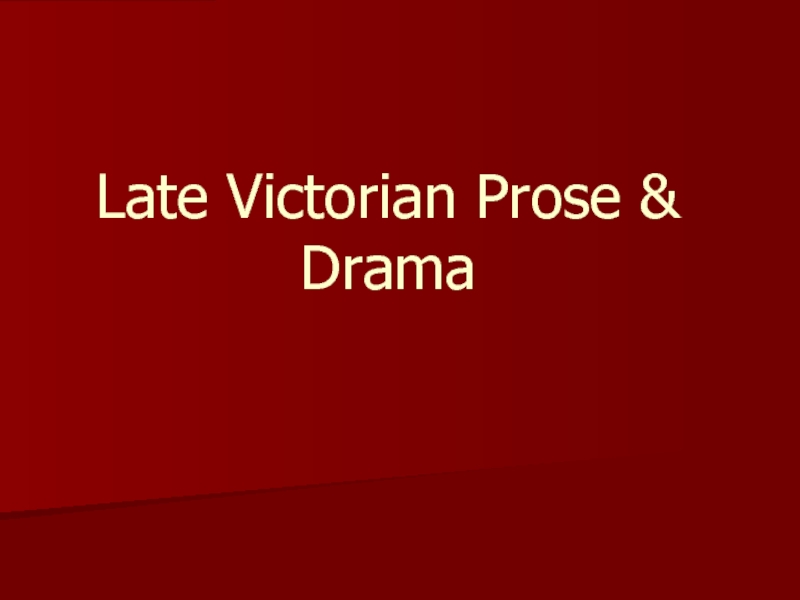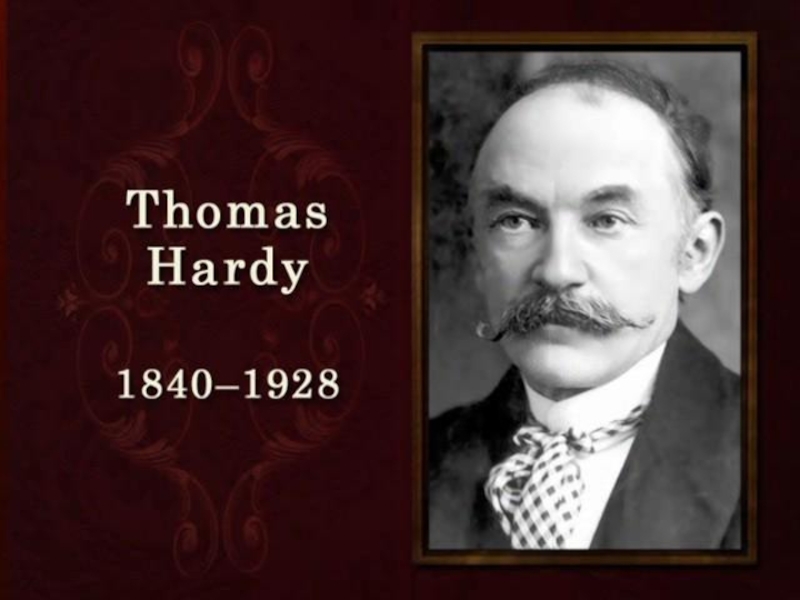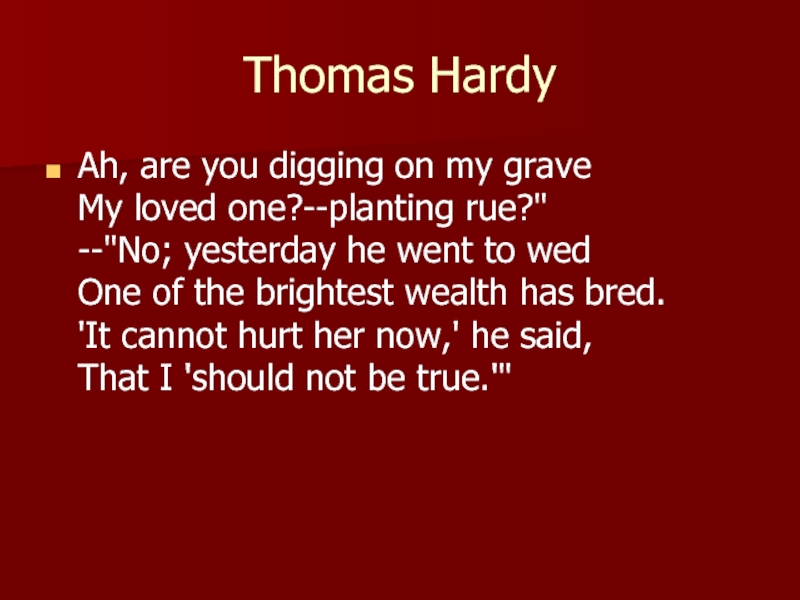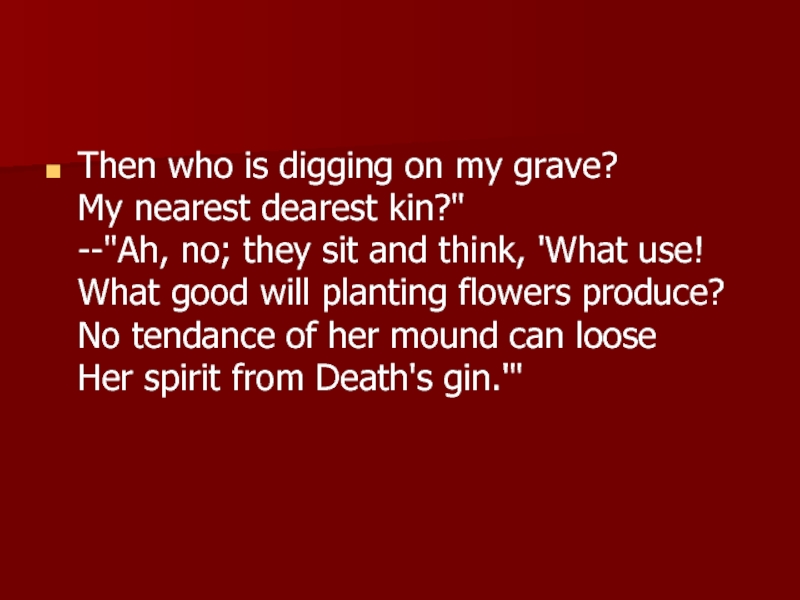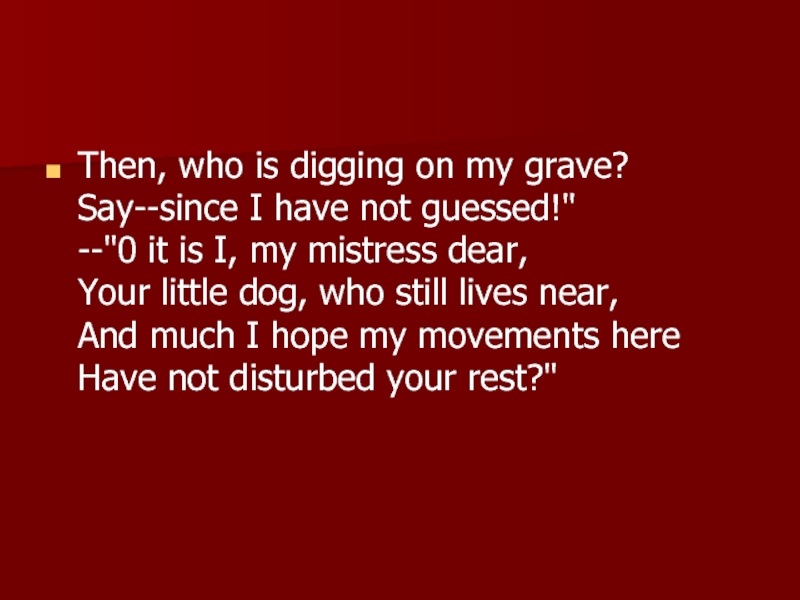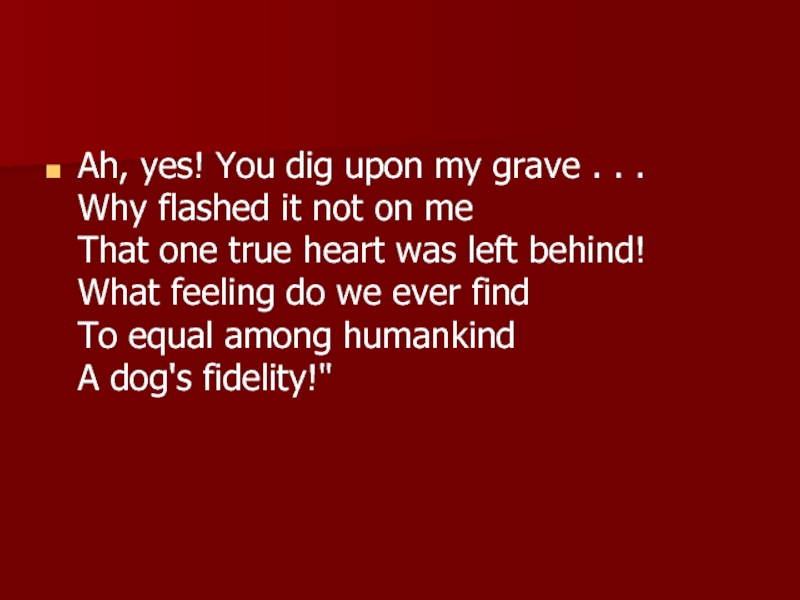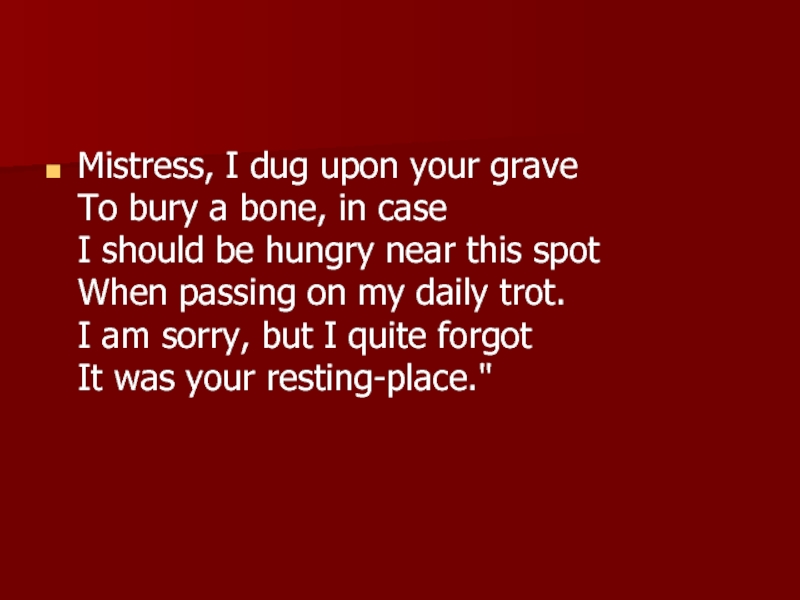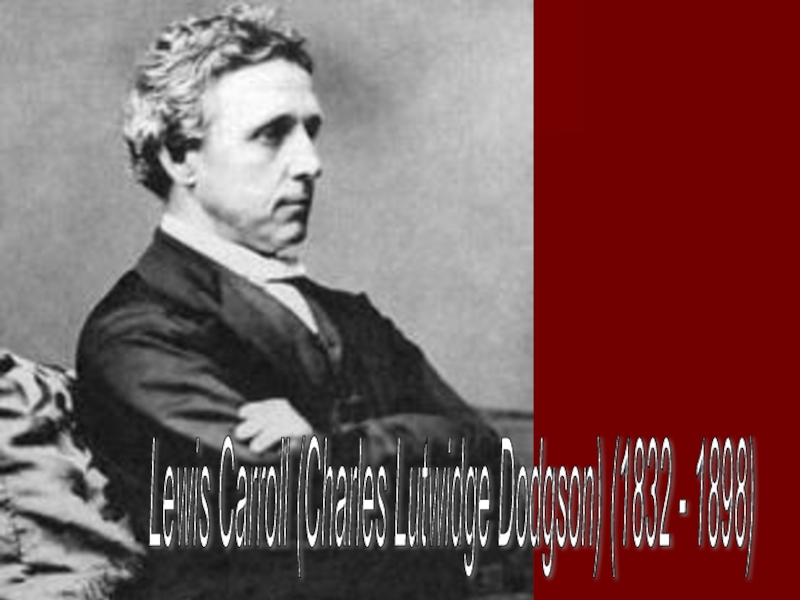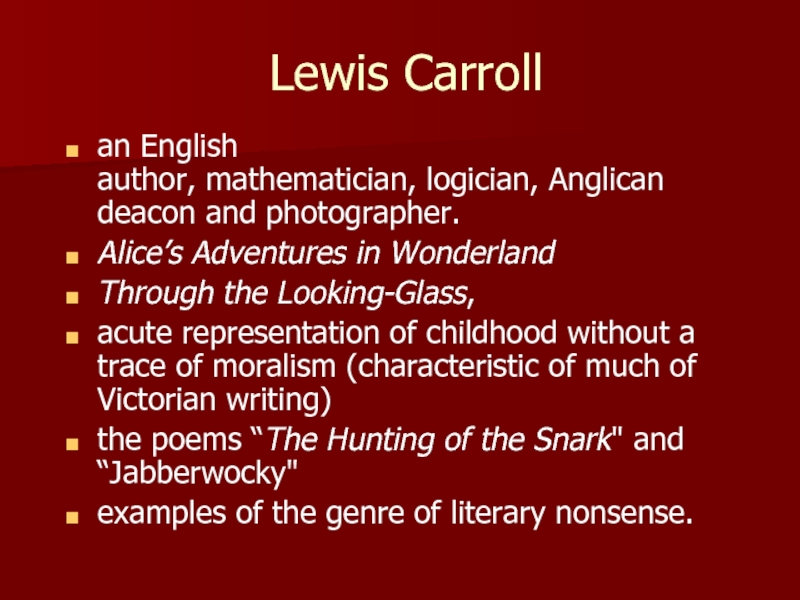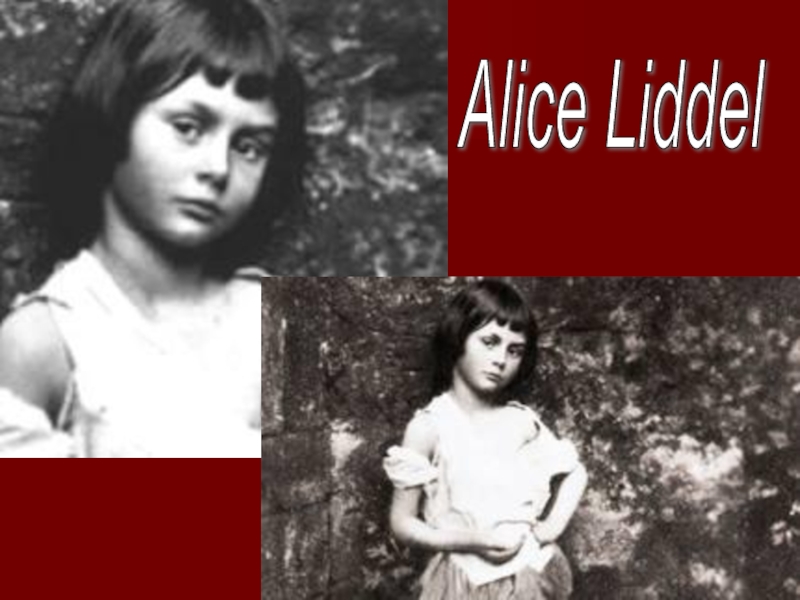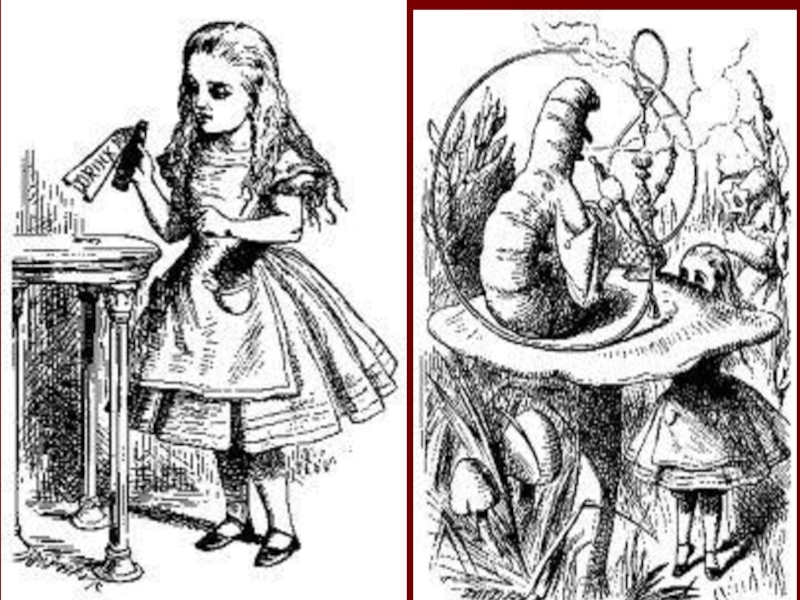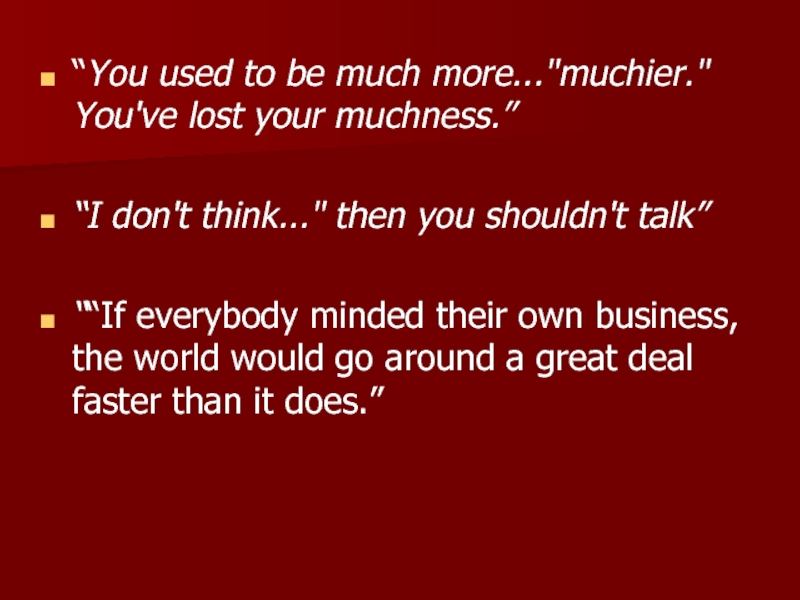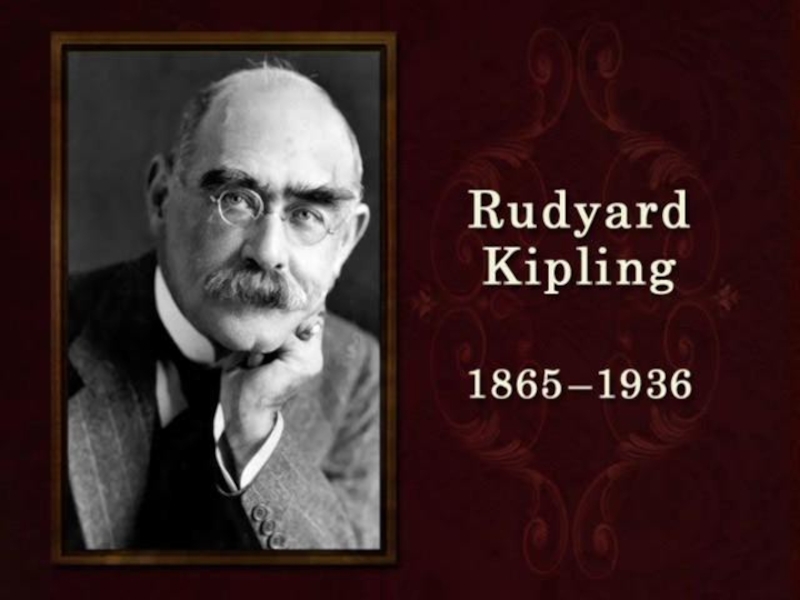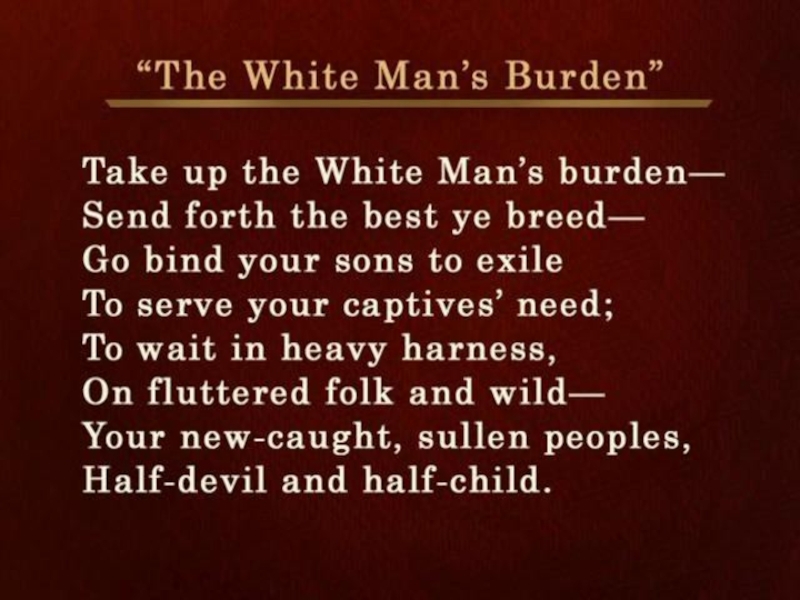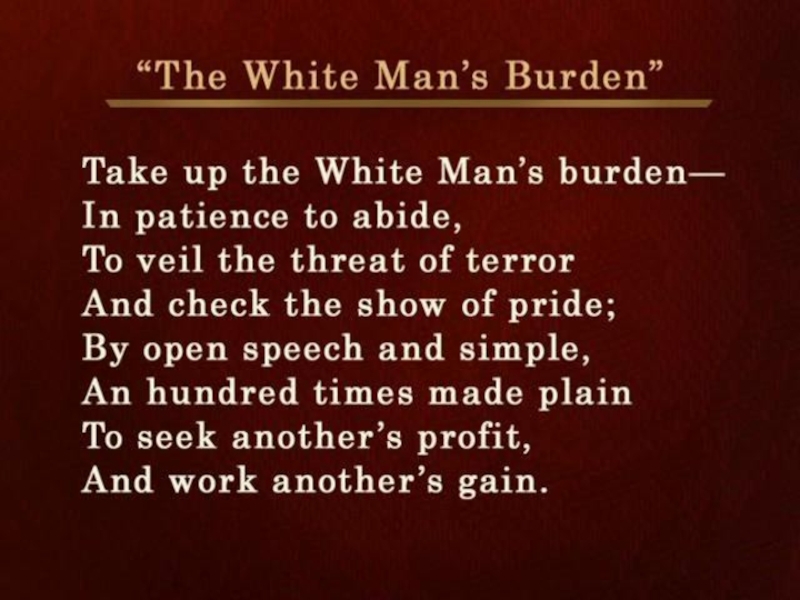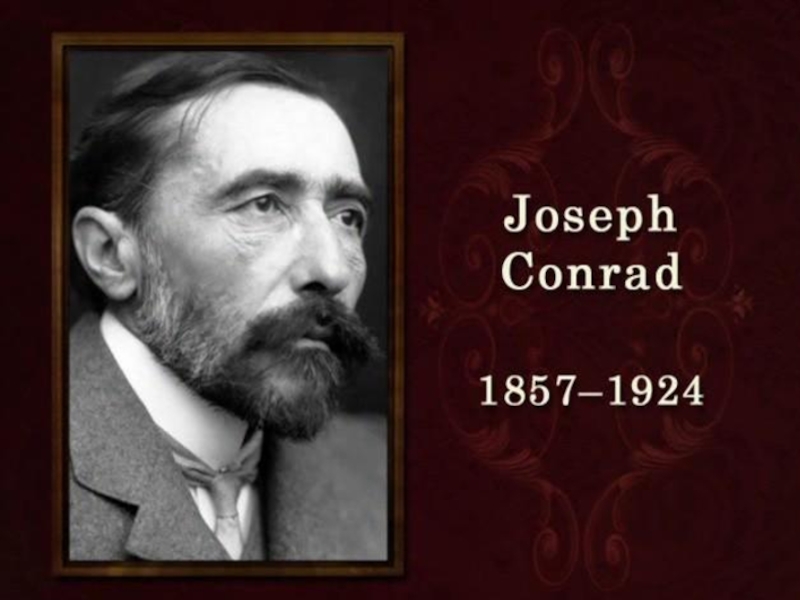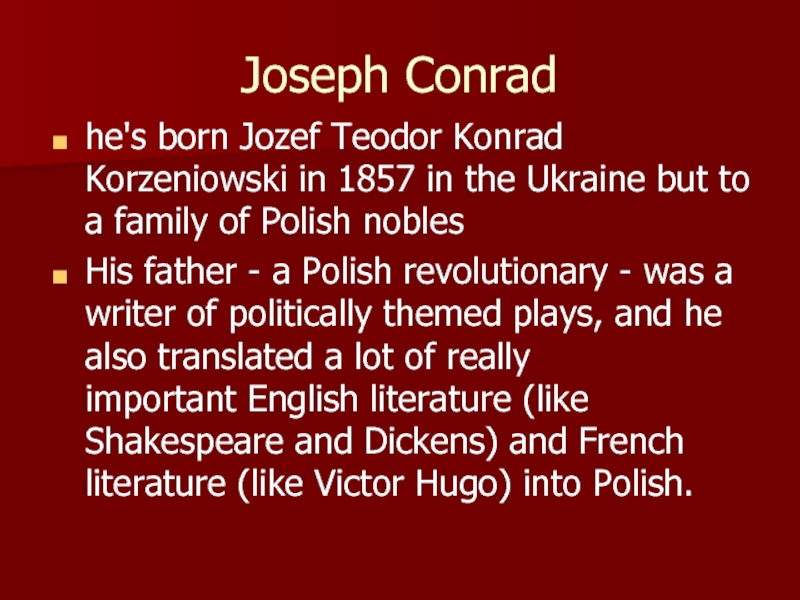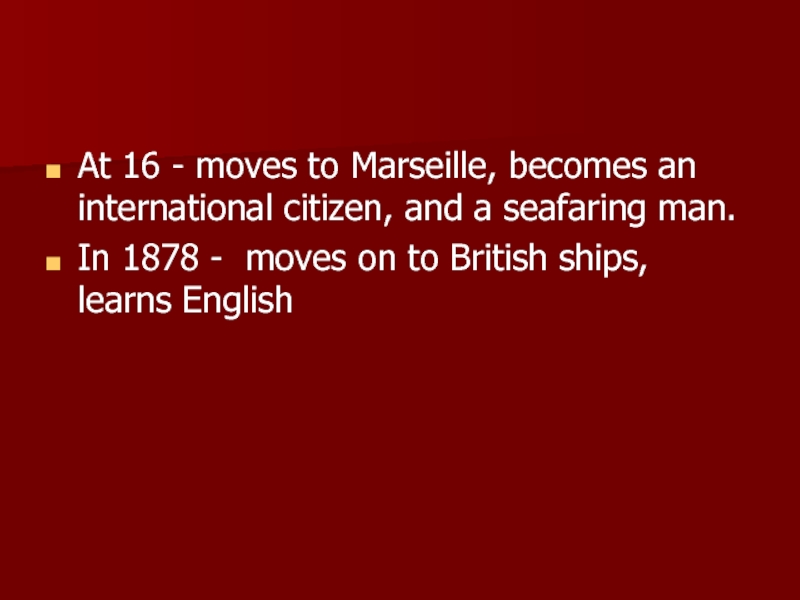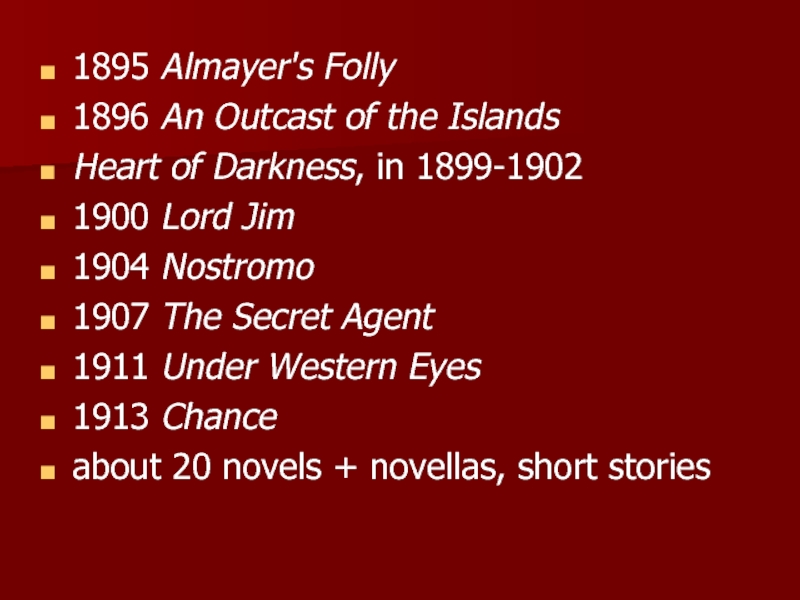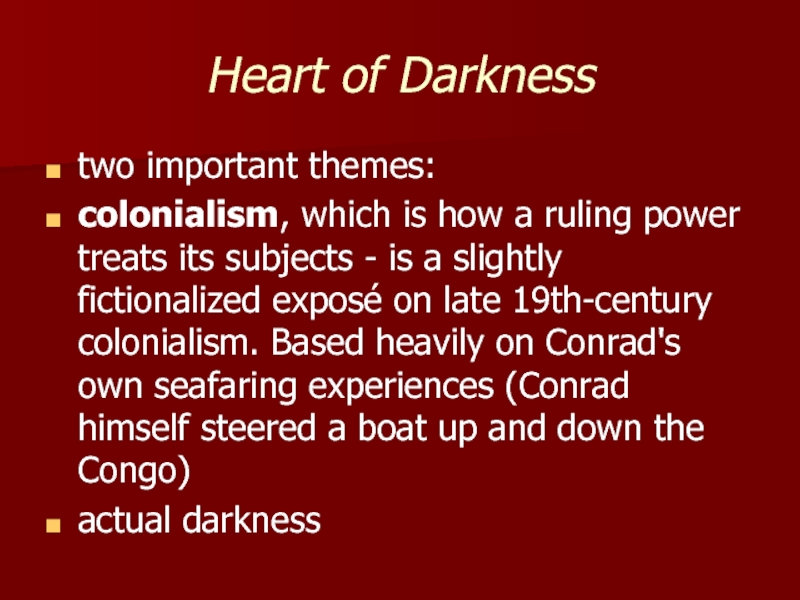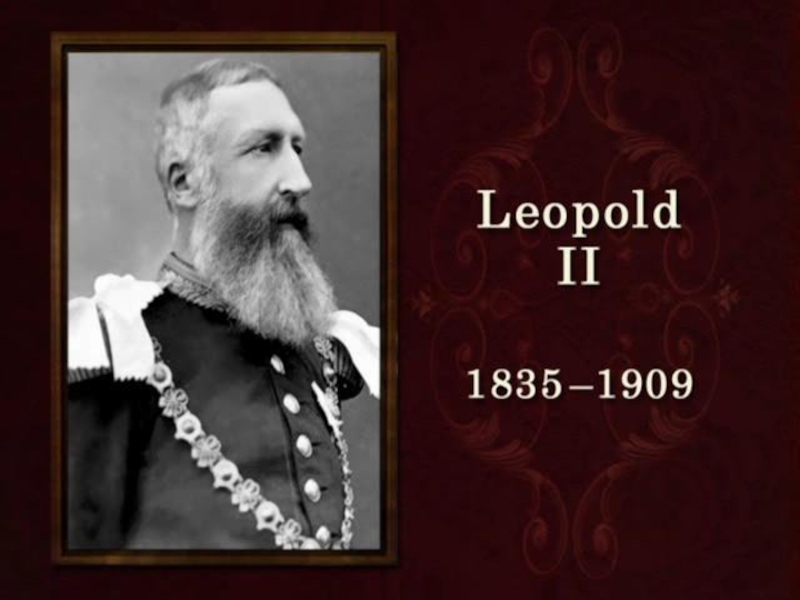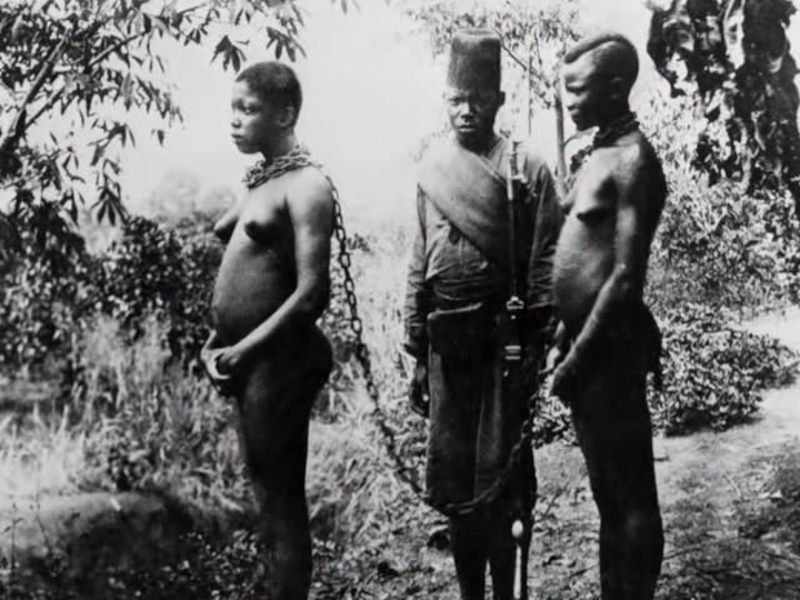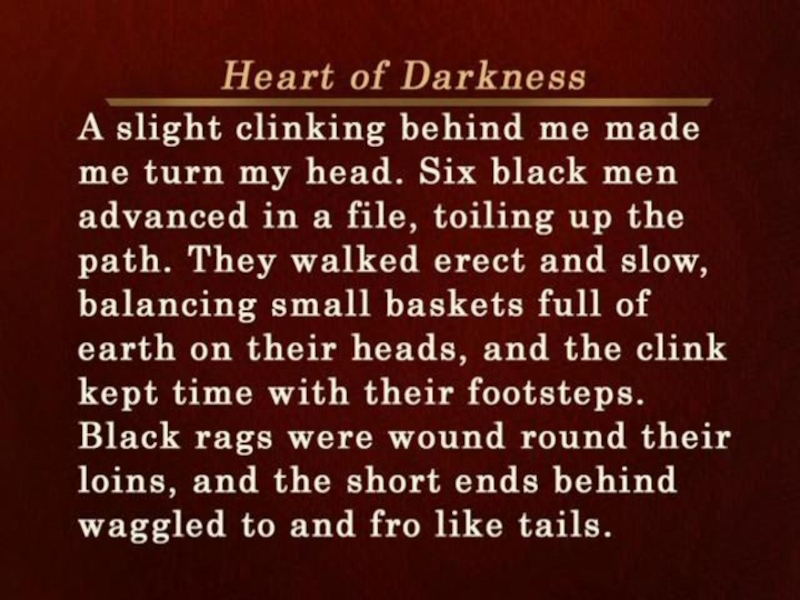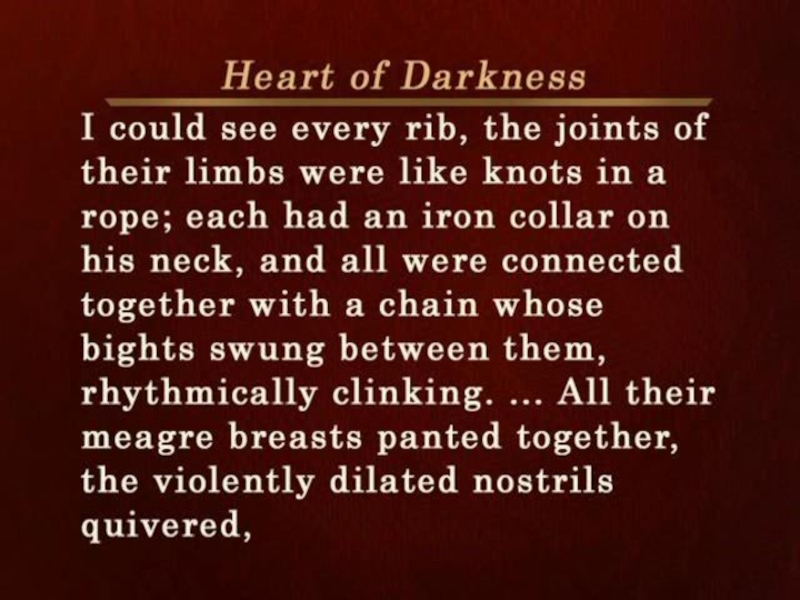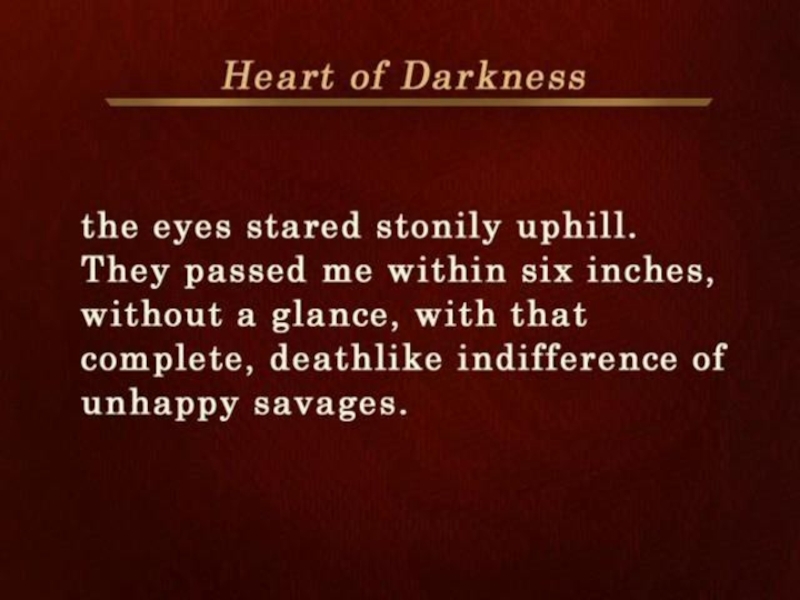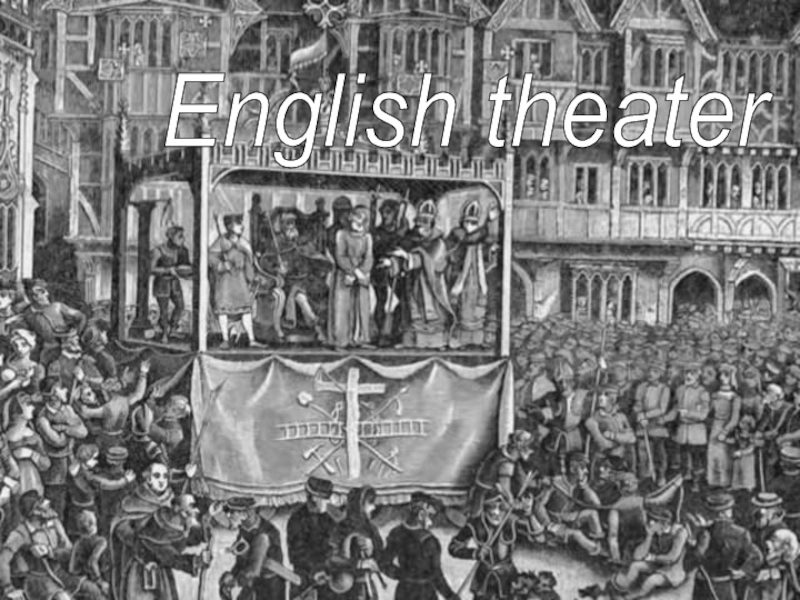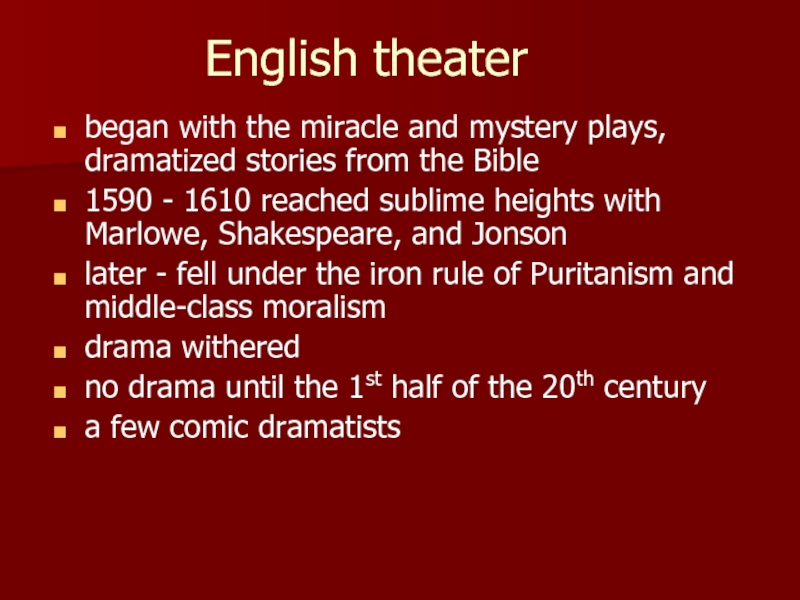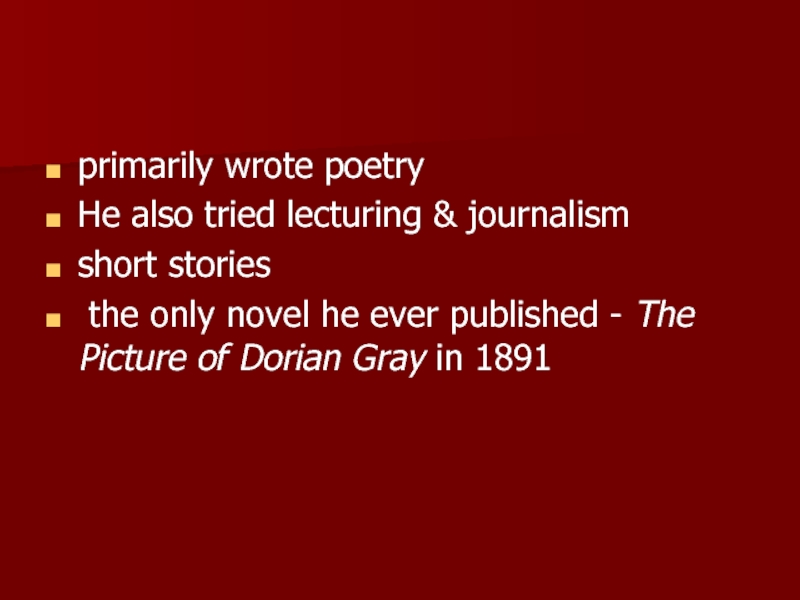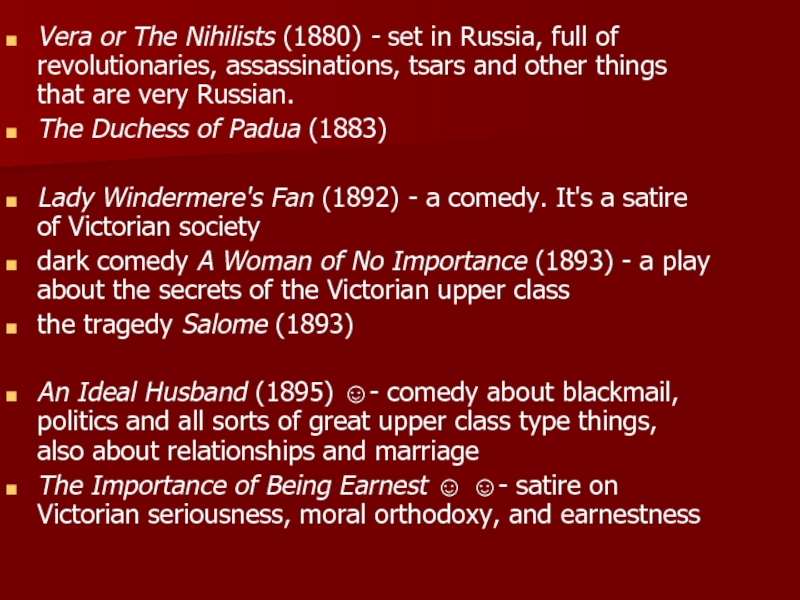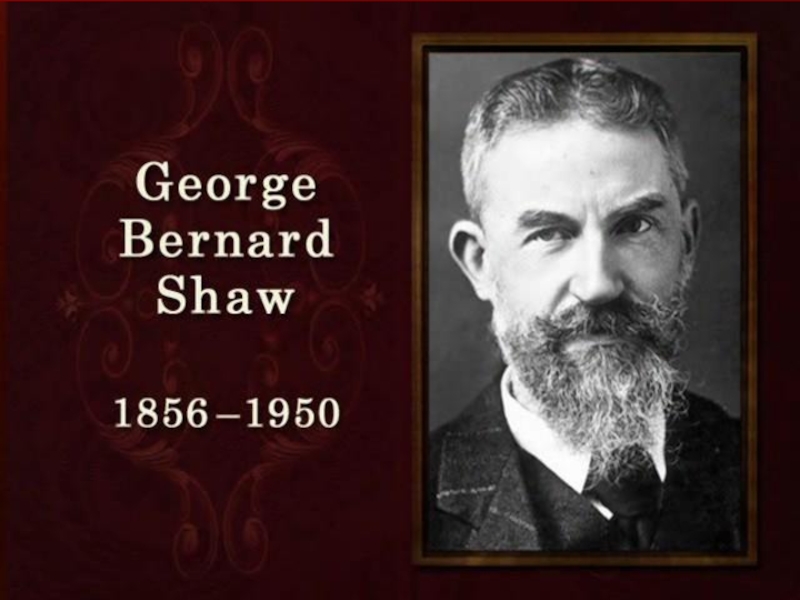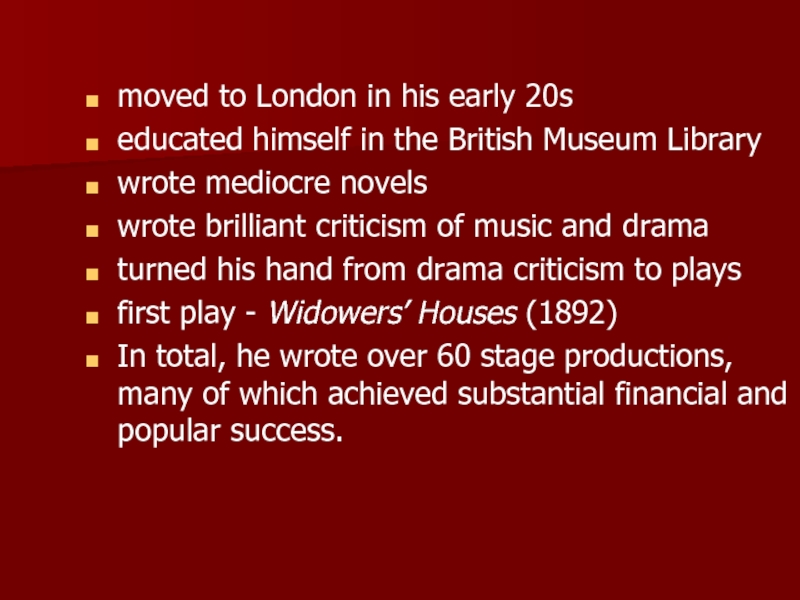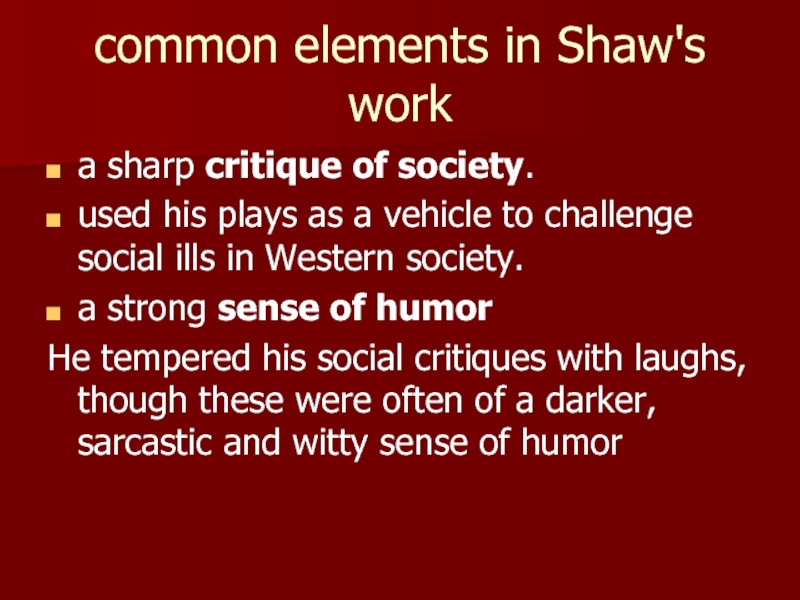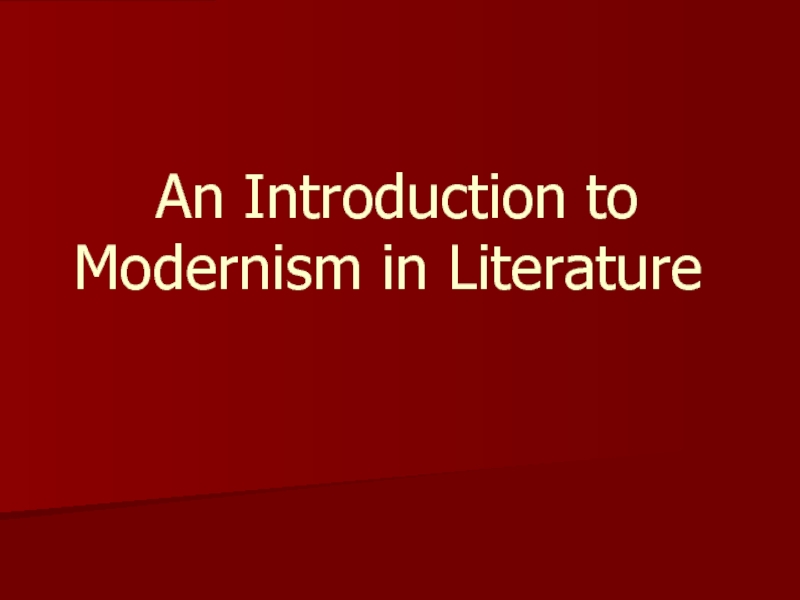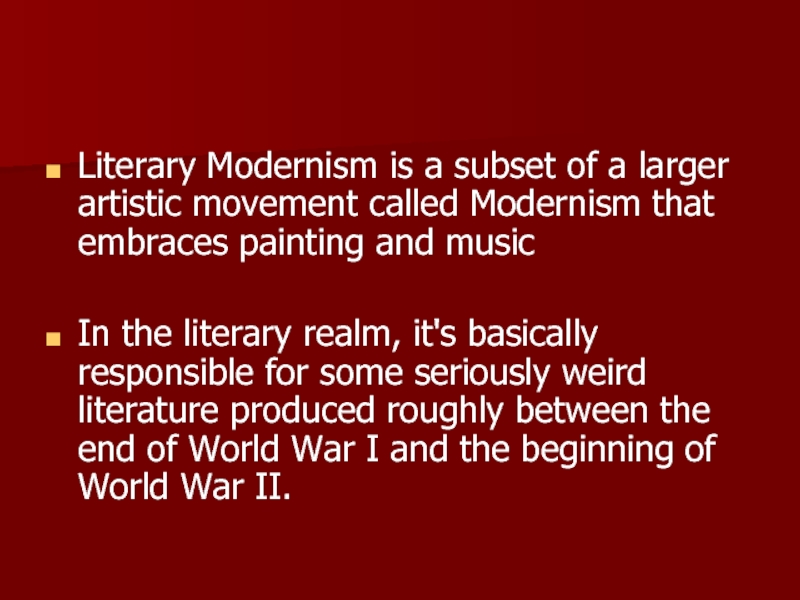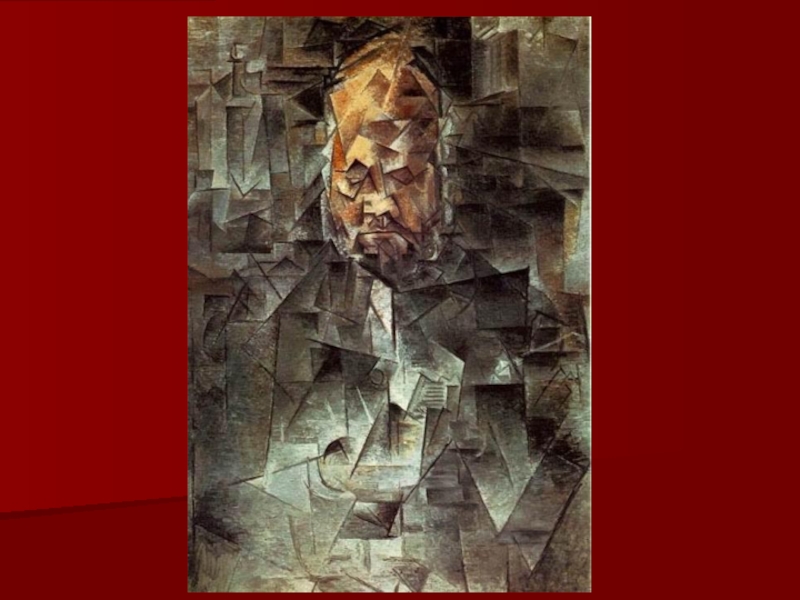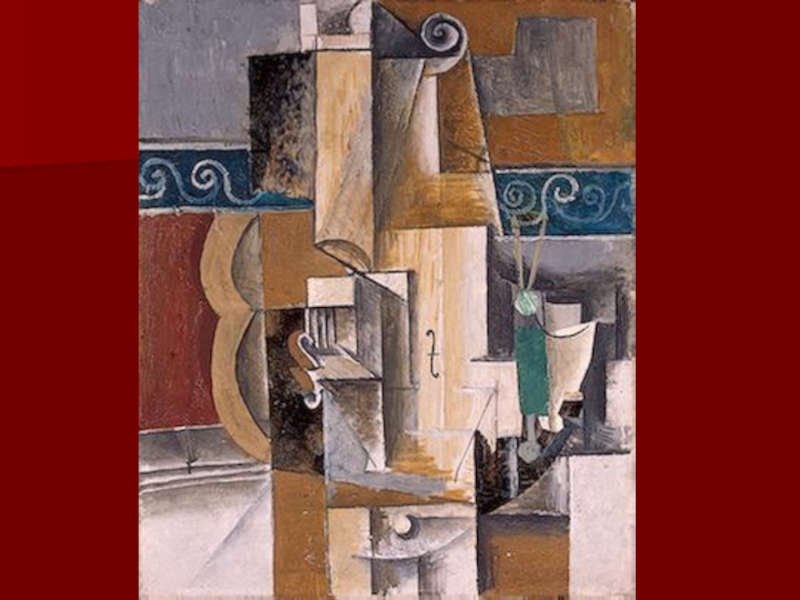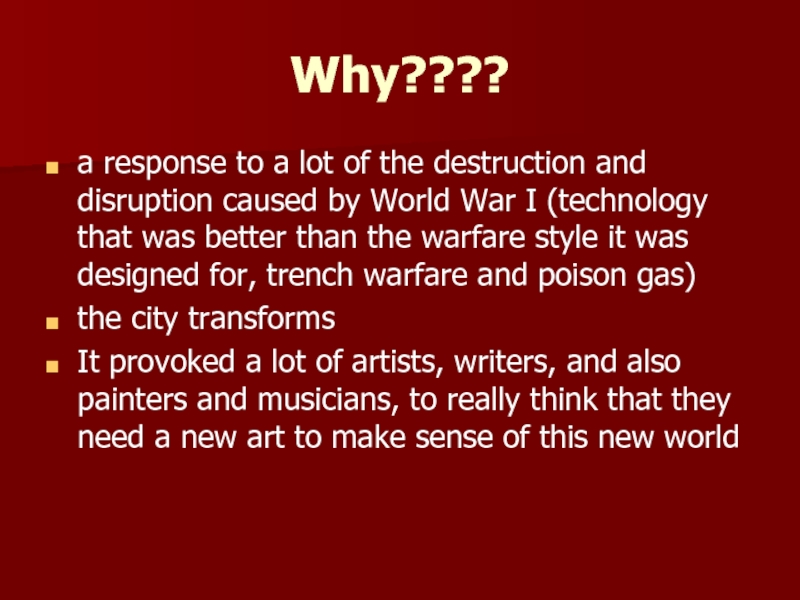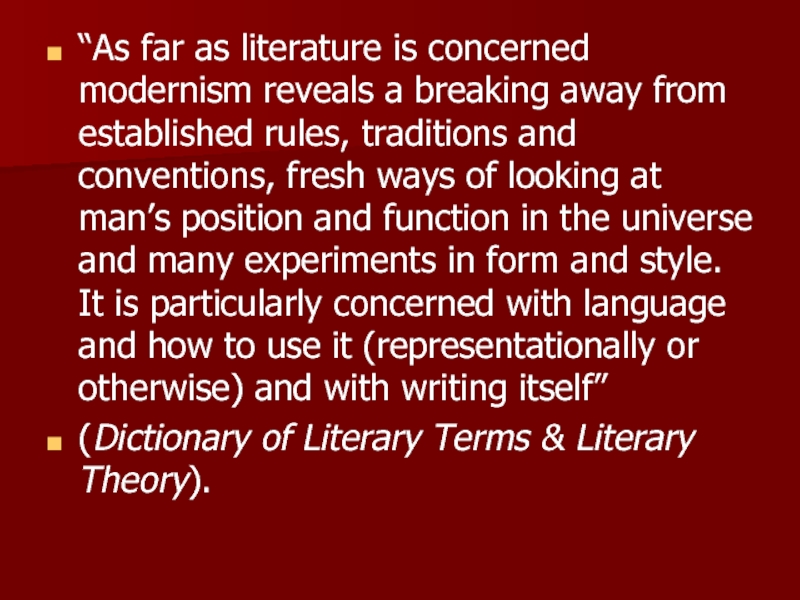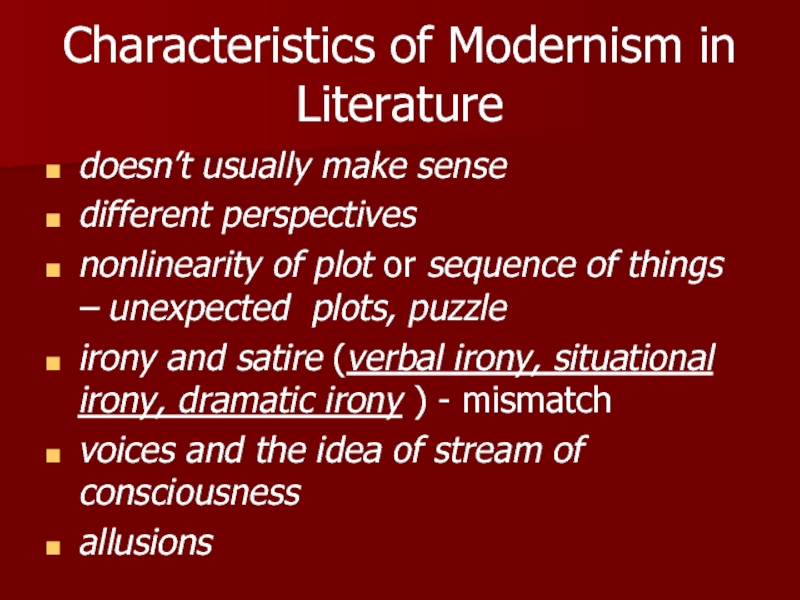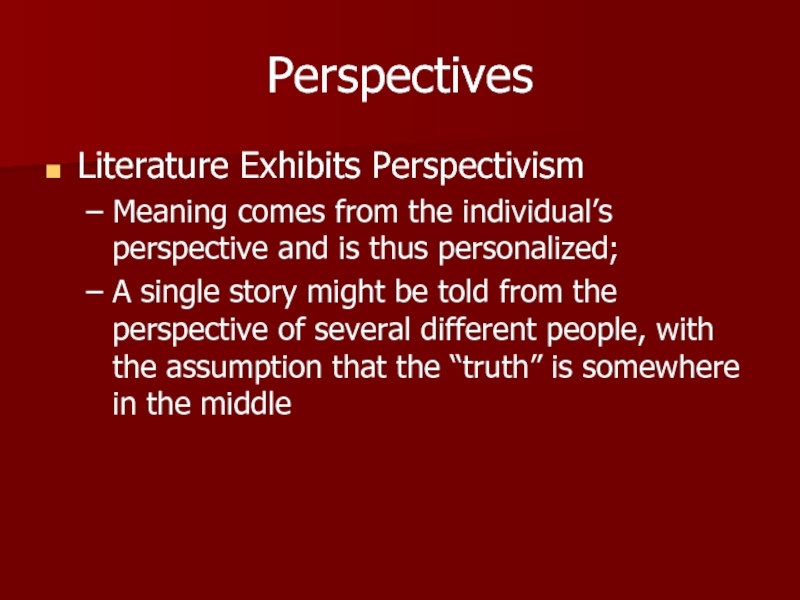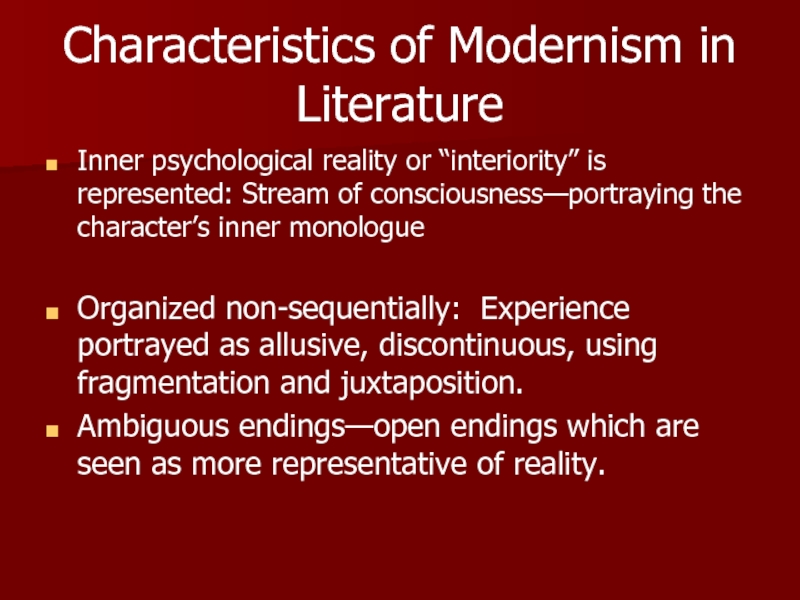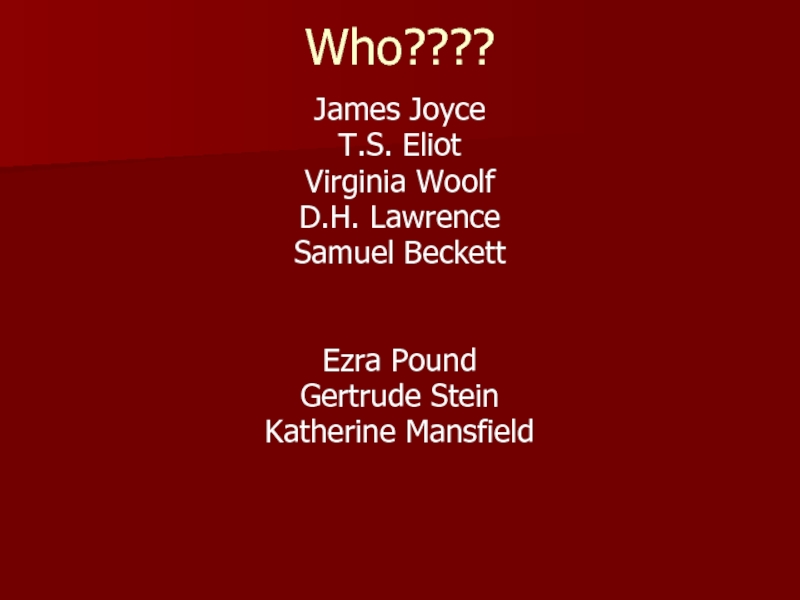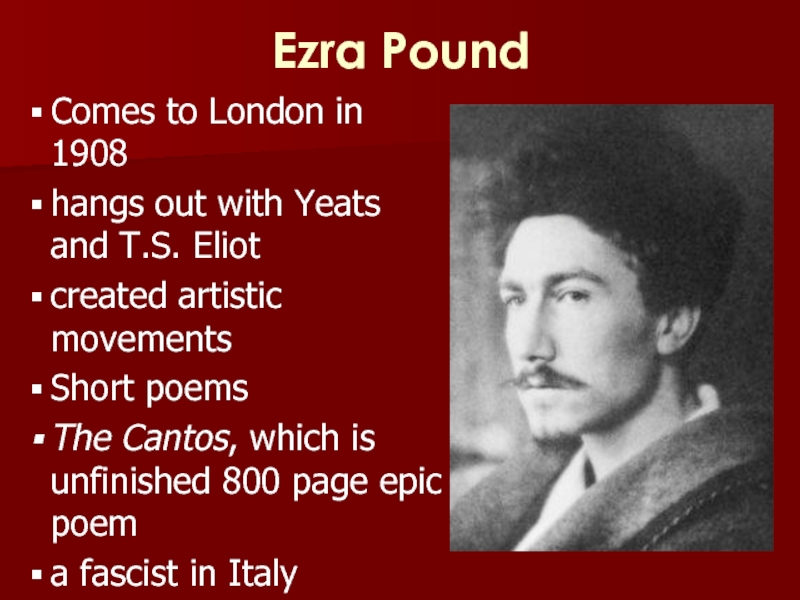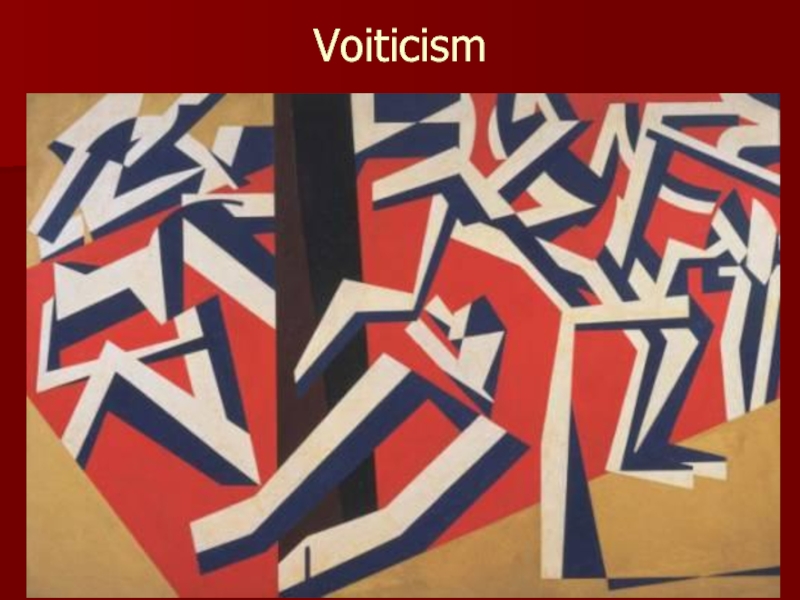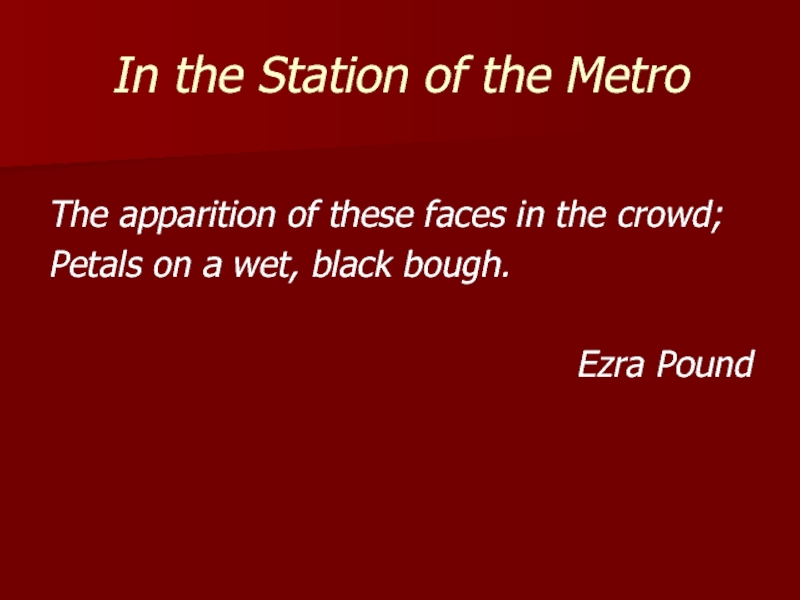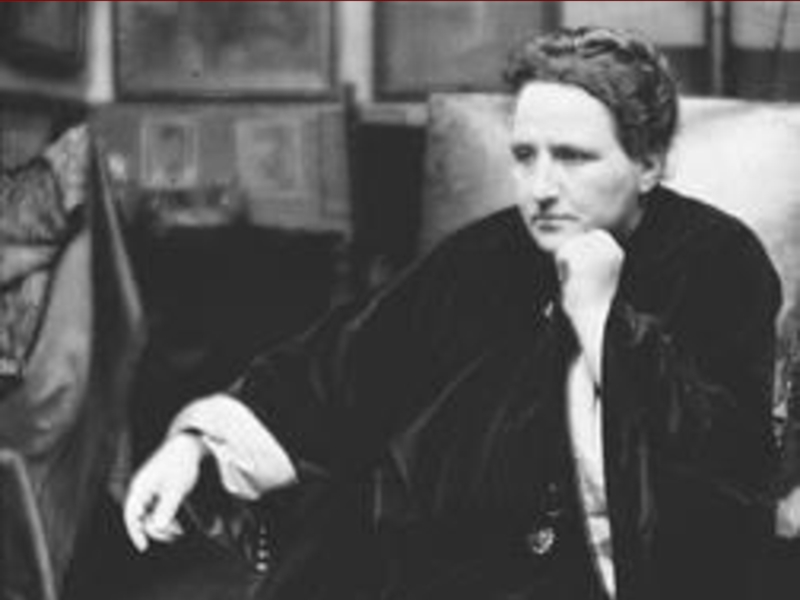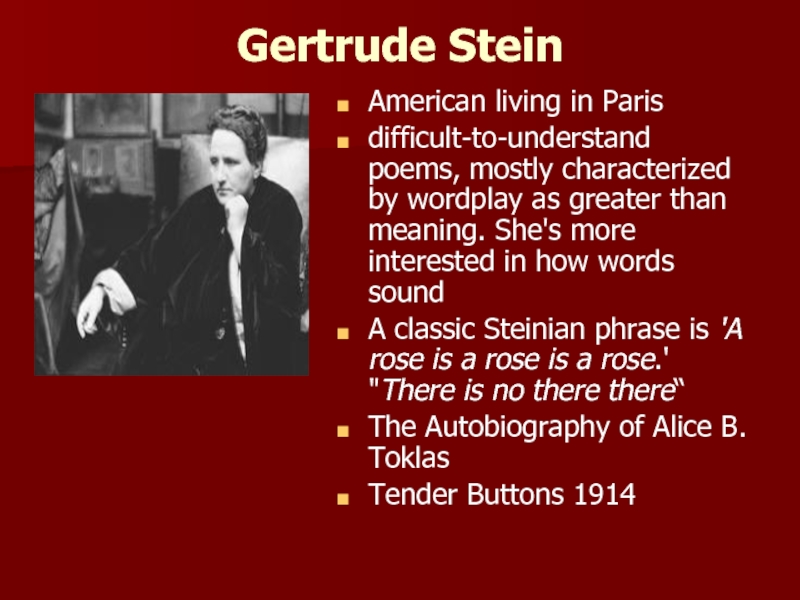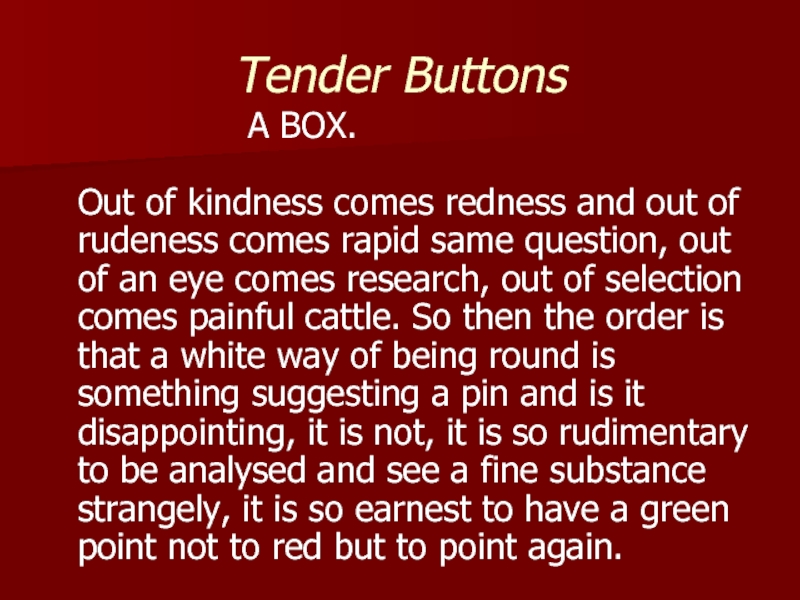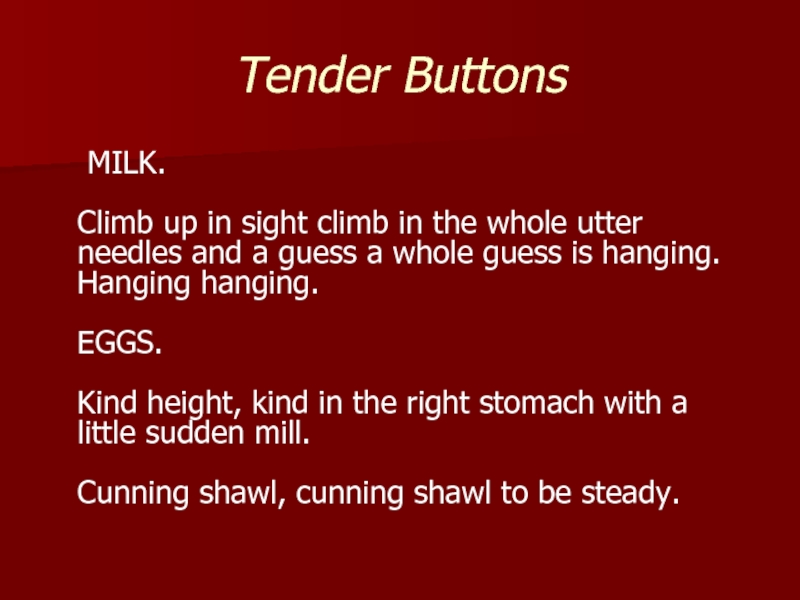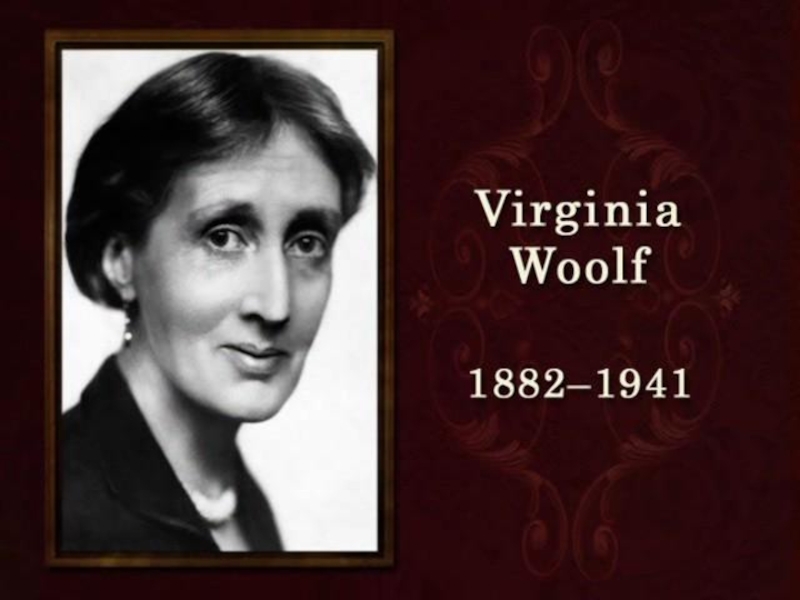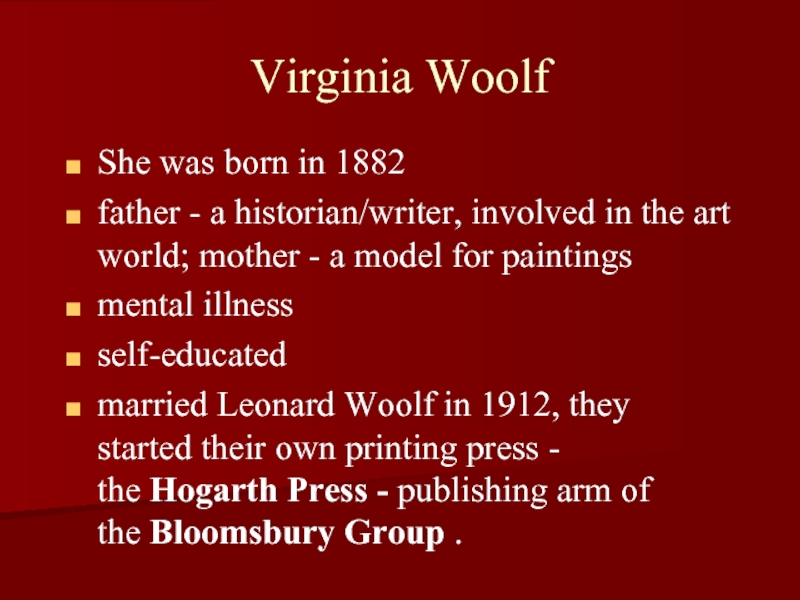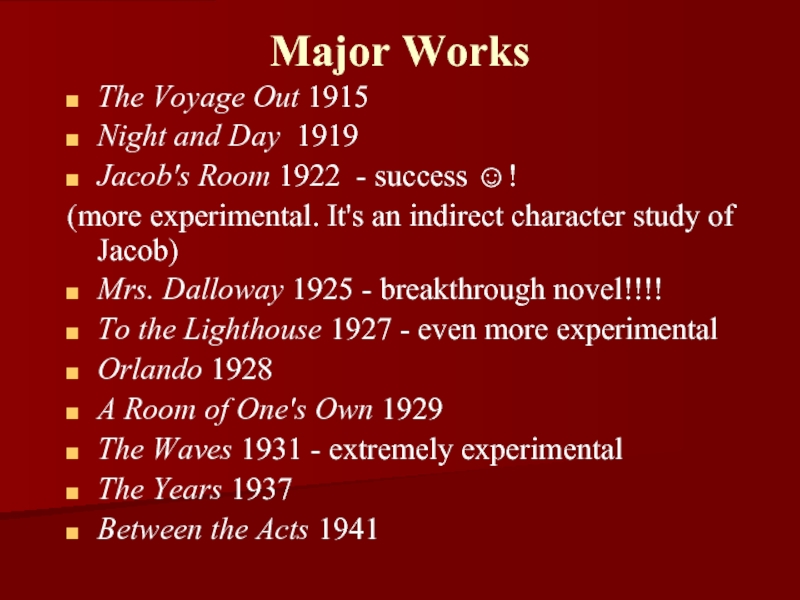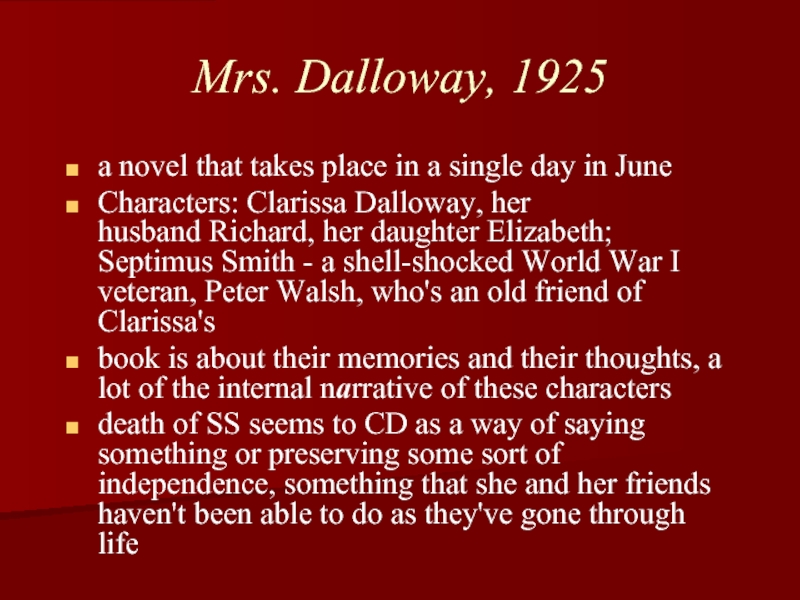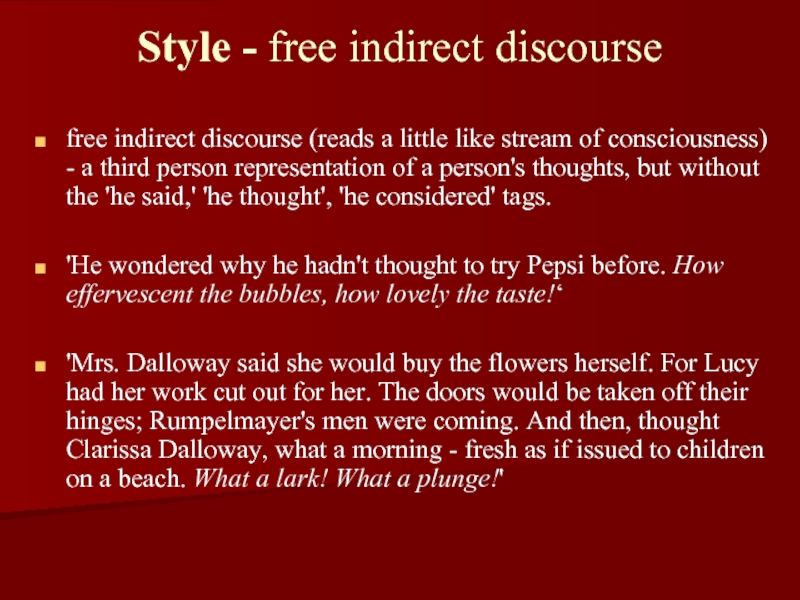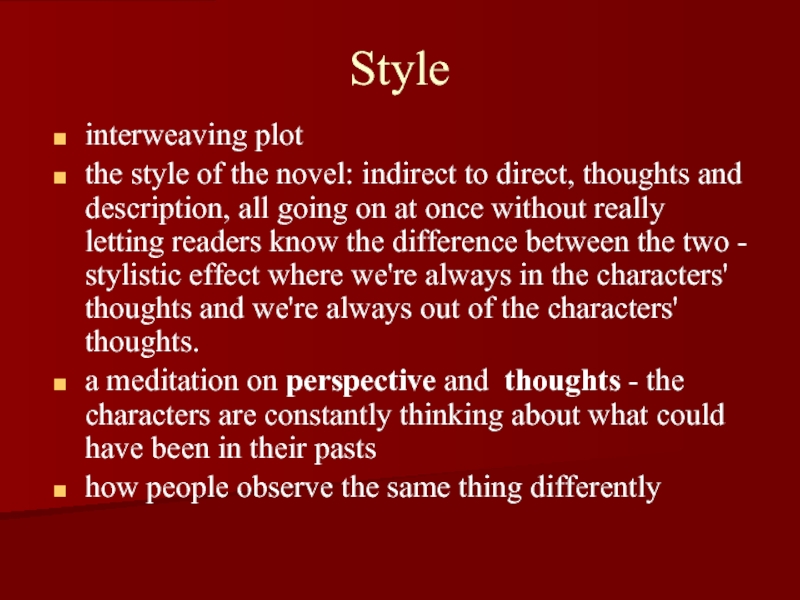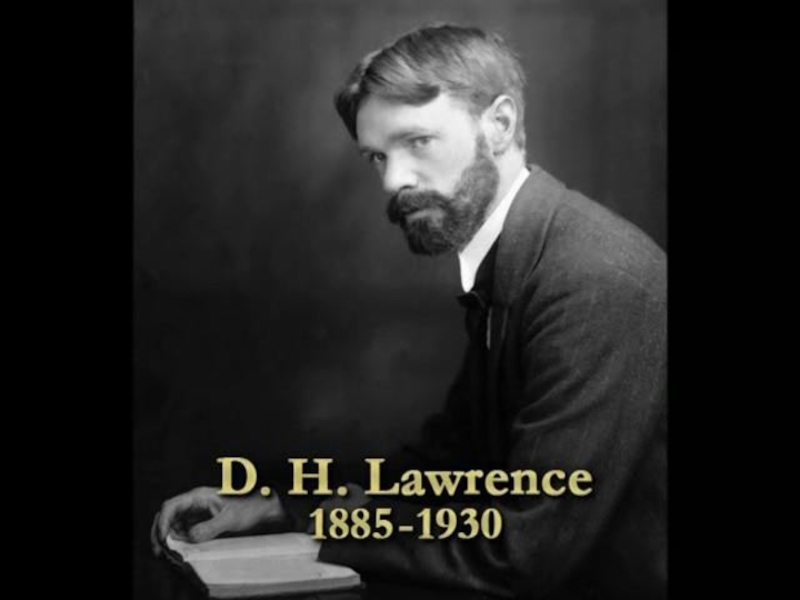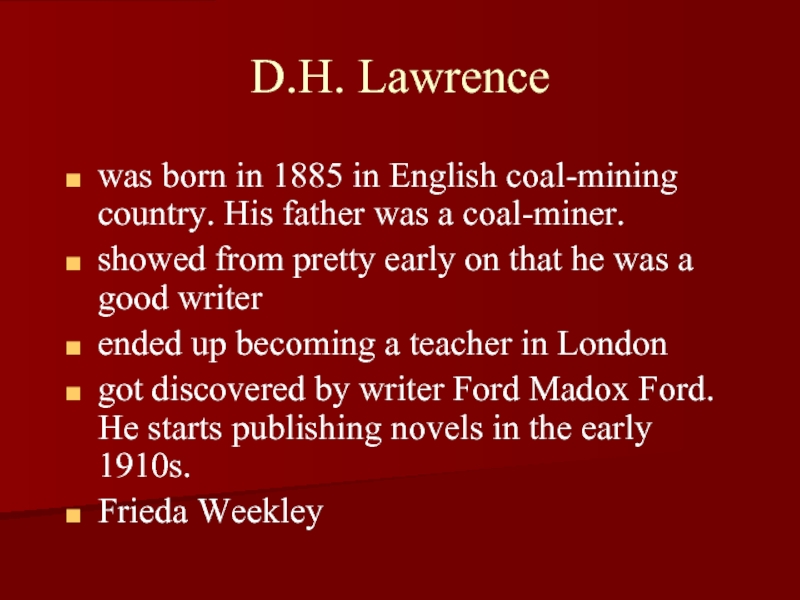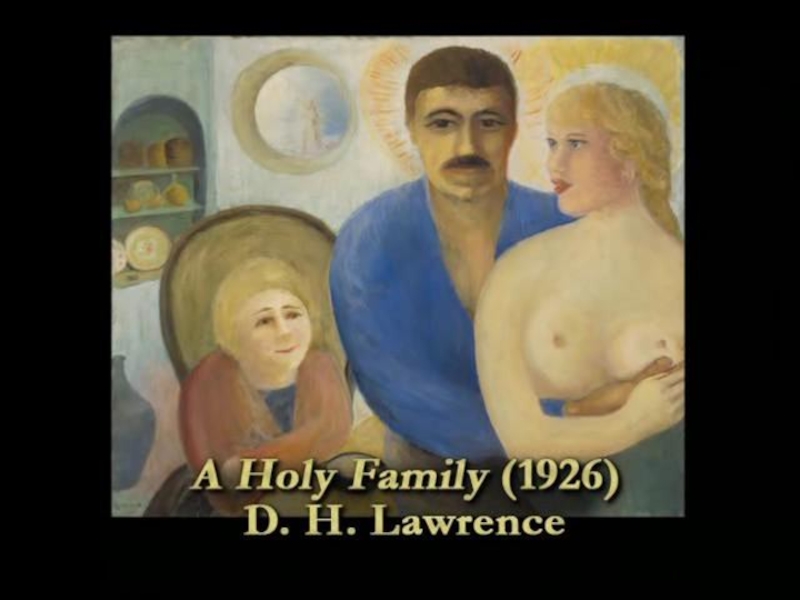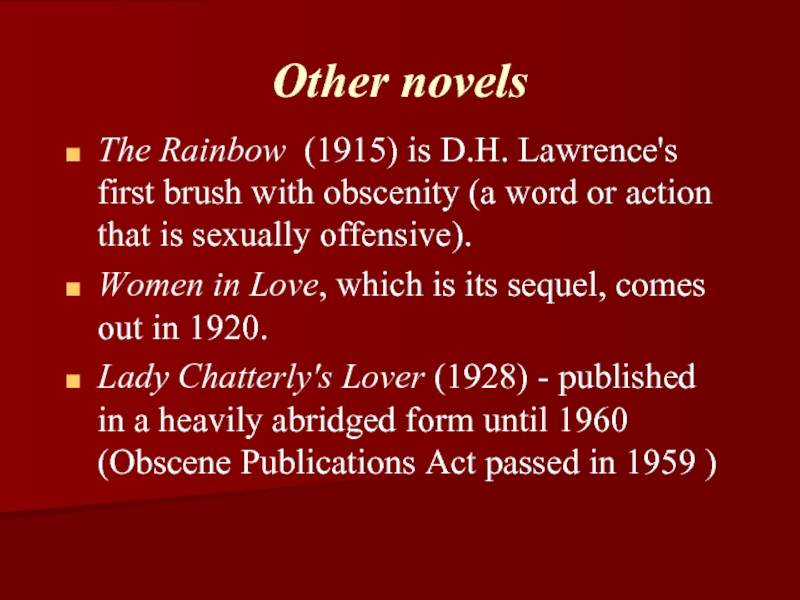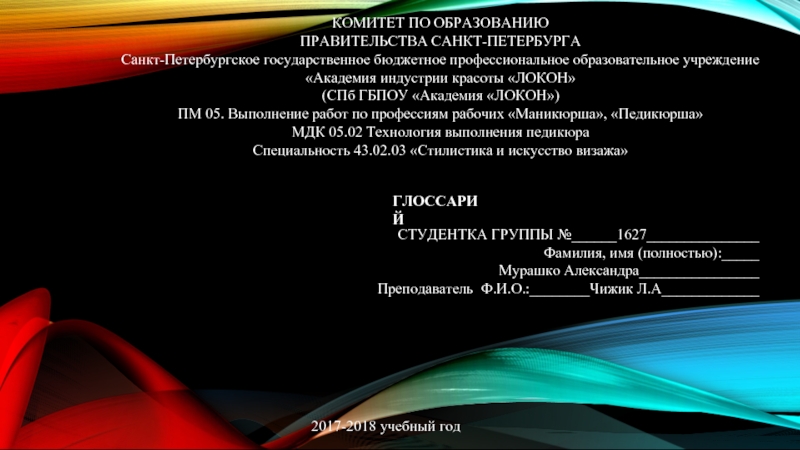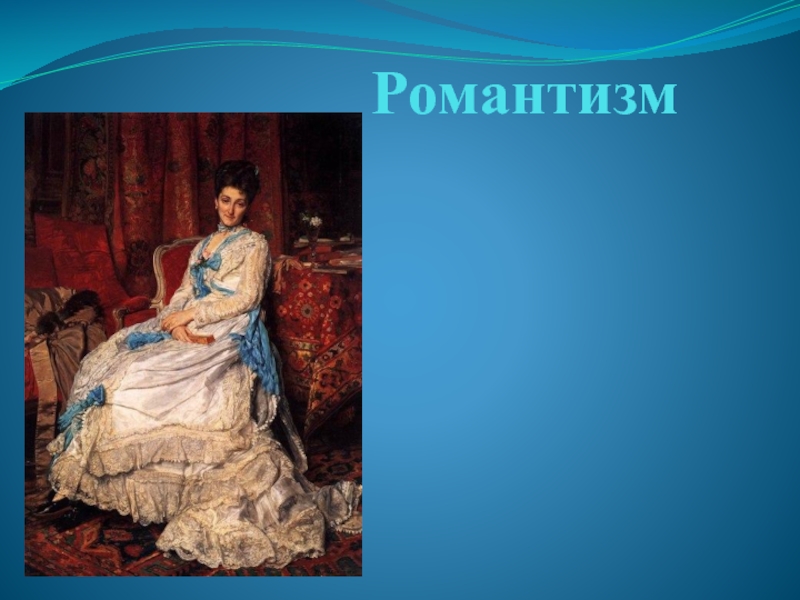- Главная
- Разное
- Дизайн
- Бизнес и предпринимательство
- Аналитика
- Образование
- Развлечения
- Красота и здоровье
- Финансы
- Государство
- Путешествия
- Спорт
- Недвижимость
- Армия
- Графика
- Культурология
- Еда и кулинария
- Лингвистика
- Английский язык
- Астрономия
- Алгебра
- Биология
- География
- Детские презентации
- Информатика
- История
- Литература
- Маркетинг
- Математика
- Медицина
- Менеджмент
- Музыка
- МХК
- Немецкий язык
- ОБЖ
- Обществознание
- Окружающий мир
- Педагогика
- Русский язык
- Технология
- Физика
- Философия
- Химия
- Шаблоны, картинки для презентаций
- Экология
- Экономика
- Юриспруденция
Late Victorian Prose and Drama презентация
Содержание
- 1. Late Victorian Prose and Drama
- 3. “Grand Old Man of English literature, towering
- 4. Thomas Hardy Ah, are you digging on
- 5. Then who is digging on my
- 6. But someone digs upon my grave?
- 7. Then, who is digging on my
- 8. Ah, yes! You dig upon my
- 9. Mistress, I dug upon your grave
- 10. Lewis Carroll (Charles Lutwidge Dodgson) (1832 - 1898)
- 11. Lewis Carroll an English author, mathematician, logician, Anglican deacon and
- 12. Alice Liddel
- 14. “You used to be much more..."muchier." You've
- 20. Joseph Conrad he's born Jozef Teodor Konrad
- 21. At 16 - moves to Marseille,
- 22. 1895 Almayer's Folly 1896 An Outcast of the
- 23. Heart of Darkness two important themes: colonialism,
- 31. English theater
- 32. English theater began with the miracle
- 34. Oscar Wilde A celebrity author is
- 35. primarily wrote poetry He also tried
- 36. Vera or The Nihilists (1880) - set in Russia,
- 38. was born in Dublin in the aftermath
- 39. moved to London in his early 20s
- 40. common elements in Shaw's work a sharp critique
- 41. An Introduction to Modernism in Literature
- 42. Literary Modernism is a subset of
- 46. Why???? a response to a lot of
- 47. “As far as literature is concerned modernism
- 48. Characteristics of Modernism in Literature doesn’t usually
- 49. Perspectives Literature Exhibits Perspectivism Meaning comes from
- 50. Characteristics of Modernism in Literature Inner psychological
- 51. Who???? James Joyce T.S. Eliot
- 52. Ezra Pound Comes to London in 1908
- 53. Voiticism
- 54. Imagism direct treatment of the
- 55. In the Station of the Metro
- 57. Gertrude Stein American living in Paris
- 58. Tender Buttons A BOX. Out of
- 59. Tender Buttons A RED STAMP. If
- 60. Tender Buttons MILK. Climb up in
- 61. Katherine Mansfield from New Zealand a
- 63. Virginia Woolf She was born in
- 64. Major Works The Voyage Out 1915
- 65. Mrs. Dalloway, 1925 a novel that
- 66. Style - free indirect discourse
- 67. Style interweaving plot the style of the
- 69. D.H. Lawrence was born in 1885
- 71. Sons and Lovers - first major book,
- 72. Other novels The Rainbow (1915) is D.H.
Слайд 3“Grand Old Man of English literature, towering over his fellow writers”
a
great novelist and a great poet
1860s - late 1890s – fiction (are quintessentially of the 19 th century, not Victorian though, not in pursuit of the standards of morality)
The Return of the Native
Tess of the d’Urbervilles
Jude the Obscure
From the turn of the century until his death, he was principally a poet (poetry properly belongs in the Modern period )
1860s - late 1890s – fiction (are quintessentially of the 19 th century, not Victorian though, not in pursuit of the standards of morality)
The Return of the Native
Tess of the d’Urbervilles
Jude the Obscure
From the turn of the century until his death, he was principally a poet (poetry properly belongs in the Modern period )
Слайд 4Thomas Hardy
Ah, are you digging on my grave
My loved one?--planting rue?"
--"No;
yesterday he went to wed
One of the brightest wealth has bred.
'It cannot hurt her now,' he said,
That I 'should not be true.'"
Слайд 5
Then who is digging on my grave?
My nearest dearest kin?"
--"Ah, no;
they sit and think, 'What use!
What good will planting flowers produce?
No tendance of her mound can loose
Her spirit from Death's gin.'"
Слайд 6
But someone digs upon my grave?
My enemy?--prodding sly?"
--"Nay; when she heard
you had passed the Gate
That shuts on all flesh soon or late,
She thought you no more worth her hate,
And cares not where you lie."
Слайд 7
Then, who is digging on my grave?
Say--since I have not guessed!"
--"0
it is I, my mistress dear,
Your little dog, who still lives near,
And much I hope my movements here
Have not disturbed your rest?"
Слайд 8
Ah, yes! You dig upon my grave . . .
Why flashed
it not on me
That one true heart was left behind!
What feeling do we ever find
To equal among humankind
A dog's fidelity!"
Слайд 9
Mistress, I dug upon your grave
To bury a bone, in case
I
should be hungry near this spot
When passing on my daily trot.
I am sorry, but I quite forgot
It was your resting-place."
Слайд 11Lewis Carroll
an English author, mathematician, logician, Anglican deacon and photographer.
Alice’s Adventures in Wonderland
Through
the Looking-Glass,
acute representation of childhood without a trace of moralism (characteristic of much of Victorian writing)
the poems “The Hunting of the Snark" and “Jabberwocky"
examples of the genre of literary nonsense.
acute representation of childhood without a trace of moralism (characteristic of much of Victorian writing)
the poems “The Hunting of the Snark" and “Jabberwocky"
examples of the genre of literary nonsense.
Слайд 14“You used to be much more..."muchier." You've lost your muchness.”
“I don't
think..." then you shouldn't talk”
““If everybody minded their own business, the world would go around a great deal faster than it does.”
““If everybody minded their own business, the world would go around a great deal faster than it does.”
Слайд 20Joseph Conrad
he's born Jozef Teodor Konrad Korzeniowski in 1857 in the
Ukraine but to a family of Polish nobles
His father - a Polish revolutionary - was a writer of politically themed plays, and he also translated a lot of really important English literature (like Shakespeare and Dickens) and French literature (like Victor Hugo) into Polish.
His father - a Polish revolutionary - was a writer of politically themed plays, and he also translated a lot of really important English literature (like Shakespeare and Dickens) and French literature (like Victor Hugo) into Polish.
Слайд 21
At 16 - moves to Marseille, becomes an international citizen, and
a seafaring man.
In 1878 - moves on to British ships, learns English
In 1878 - moves on to British ships, learns English
Слайд 221895 Almayer's Folly
1896 An Outcast of the Islands
Heart of Darkness, in 1899-1902
1900 Lord
Jim
1904 Nostromo
1907 The Secret Agent
1911 Under Western Eyes
1913 Chance
about 20 novels + novellas, short stories
1904 Nostromo
1907 The Secret Agent
1911 Under Western Eyes
1913 Chance
about 20 novels + novellas, short stories
Слайд 23Heart of Darkness
two important themes:
colonialism, which is how a ruling power
treats its subjects - is a slightly fictionalized exposé on late 19th-century colonialism. Based heavily on Conrad's own seafaring experiences (Conrad himself steered a boat up and down the Congo)
actual darkness
actual darkness
Слайд 32English theater
began with the miracle and mystery plays, dramatized stories
from the Bible
1590 - 1610 reached sublime heights with Marlowe, Shakespeare, and Jonson
later - fell under the iron rule of Puritanism and middle-class moralism
drama withered
no drama until the 1st half of the 20th century
a few comic dramatists
1590 - 1610 reached sublime heights with Marlowe, Shakespeare, and Jonson
later - fell under the iron rule of Puritanism and middle-class moralism
drama withered
no drama until the 1st half of the 20th century
a few comic dramatists
Слайд 34Oscar Wilde
A celebrity author is one whose public image is
better known than his or her works
Wilde himself liked to assert that his major work of art was himself.
was born in 1854 in Dublin
still in school – helped popularize aestheticism - art for art's sake; it doesn't have a greater purpose. It's not trying to do anything socially, politically. It's beautiful, and it's art. ”The beauty of objects might improve the quality of life”
I find it harder every day to live up to my blue china…
Wilde himself liked to assert that his major work of art was himself.
was born in 1854 in Dublin
still in school – helped popularize aestheticism - art for art's sake; it doesn't have a greater purpose. It's not trying to do anything socially, politically. It's beautiful, and it's art. ”The beauty of objects might improve the quality of life”
I find it harder every day to live up to my blue china…
Слайд 35
primarily wrote poetry
He also tried lecturing & journalism
short stories
the only novel
he ever published - The Picture of Dorian Gray in 1891
Слайд 36Vera or The Nihilists (1880) - set in Russia, full of revolutionaries, assassinations,
tsars and other things that are very Russian.
The Duchess of Padua (1883)
Lady Windermere's Fan (1892) - a comedy. It's a satire of Victorian society
dark comedy A Woman of No Importance (1893) - a play about the secrets of the Victorian upper class
the tragedy Salome (1893)
An Ideal Husband (1895) ☺- comedy about blackmail, politics and all sorts of great upper class type things, also about relationships and marriage
The Importance of Being Earnest ☺ ☺- satire on Victorian seriousness, moral orthodoxy, and earnestness
The Duchess of Padua (1883)
Lady Windermere's Fan (1892) - a comedy. It's a satire of Victorian society
dark comedy A Woman of No Importance (1893) - a play about the secrets of the Victorian upper class
the tragedy Salome (1893)
An Ideal Husband (1895) ☺- comedy about blackmail, politics and all sorts of great upper class type things, also about relationships and marriage
The Importance of Being Earnest ☺ ☺- satire on Victorian seriousness, moral orthodoxy, and earnestness
Слайд 38was born in Dublin in the aftermath of the famine of
the late 1840s, a catastrophe during which Ireland lost half its population
was educated in Dublin as a modestly privileged child of the Protestant ascendancy
his parents separated when he was 16; families and family relationships would mean nothing to him thereafter. Shaw came to see marriage as nothing more than licensed prostitution: Every marriage was a marriage of convenience (Getting Married , Mrs. Warren’s Profession)
School was not much to Shaw’s taste: schools were “prisons” in which children were kept to prevent them from “disturbing” their parents.
was educated in Dublin as a modestly privileged child of the Protestant ascendancy
his parents separated when he was 16; families and family relationships would mean nothing to him thereafter. Shaw came to see marriage as nothing more than licensed prostitution: Every marriage was a marriage of convenience (Getting Married , Mrs. Warren’s Profession)
School was not much to Shaw’s taste: schools were “prisons” in which children were kept to prevent them from “disturbing” their parents.
Слайд 39moved to London in his early 20s
educated himself in the
British Museum Library
wrote mediocre novels
wrote brilliant criticism of music and drama
turned his hand from drama criticism to plays
first play - Widowers’ Houses (1892)
In total, he wrote over 60 stage productions, many of which achieved substantial financial and popular success.
wrote mediocre novels
wrote brilliant criticism of music and drama
turned his hand from drama criticism to plays
first play - Widowers’ Houses (1892)
In total, he wrote over 60 stage productions, many of which achieved substantial financial and popular success.
Слайд 40common elements in Shaw's work
a sharp critique of society.
used his plays
as a vehicle to challenge social ills in Western society.
a strong sense of humor
He tempered his social critiques with laughs, though these were often of a darker, sarcastic and witty sense of humor
a strong sense of humor
He tempered his social critiques with laughs, though these were often of a darker, sarcastic and witty sense of humor
Слайд 42
Literary Modernism is a subset of a larger artistic movement called
Modernism that embraces painting and music
In the literary realm, it's basically responsible for some seriously weird literature produced roughly between the end of World War I and the beginning of World War II.
In the literary realm, it's basically responsible for some seriously weird literature produced roughly between the end of World War I and the beginning of World War II.
Слайд 46Why????
a response to a lot of the destruction and disruption caused
by World War I (technology that was better than the warfare style it was designed for, trench warfare and poison gas)
the city transforms
It provoked a lot of artists, writers, and also painters and musicians, to really think that they need a new art to make sense of this new world
the city transforms
It provoked a lot of artists, writers, and also painters and musicians, to really think that they need a new art to make sense of this new world
Слайд 47“As far as literature is concerned modernism reveals a breaking away
from established rules, traditions and conventions, fresh ways of looking at man’s position and function in the universe and many experiments in form and style. It is particularly concerned with language and how to use it (representationally or otherwise) and with writing itself”
(Dictionary of Literary Terms & Literary Theory).
(Dictionary of Literary Terms & Literary Theory).
Слайд 48Characteristics of Modernism in Literature
doesn’t usually make sense
different perspectives
nonlinearity of
plot or sequence of things – unexpected plots, puzzle
irony and satire (verbal irony, situational irony, dramatic irony ) - mismatch
voices and the idea of stream of consciousness
allusions
irony and satire (verbal irony, situational irony, dramatic irony ) - mismatch
voices and the idea of stream of consciousness
allusions
Слайд 49Perspectives
Literature Exhibits Perspectivism
Meaning comes from the individual’s perspective and is thus
personalized;
A single story might be told from the perspective of several different people, with the assumption that the “truth” is somewhere in the middle
A single story might be told from the perspective of several different people, with the assumption that the “truth” is somewhere in the middle
Слайд 50Characteristics of Modernism in Literature
Inner psychological reality or “interiority” is represented:
Stream of consciousness—portraying the character’s inner monologue
Organized non-sequentially: Experience portrayed as allusive, discontinuous, using fragmentation and juxtaposition.
Ambiguous endings—open endings which are seen as more representative of reality.
Organized non-sequentially: Experience portrayed as allusive, discontinuous, using fragmentation and juxtaposition.
Ambiguous endings—open endings which are seen as more representative of reality.
Слайд 51Who????
James Joyce
T.S. Eliot
Virginia Woolf
D.H. Lawrence
Samuel Beckett
Ezra
Pound
Gertrude Stein
Katherine Mansfield
Gertrude Stein
Katherine Mansfield
Слайд 52Ezra Pound
Comes to London in 1908
hangs out with Yeats and
T.S. Eliot
created artistic movements
Short poems
The Cantos, which is unfinished 800 page epic poem
a fascist in Italy
created artistic movements
Short poems
The Cantos, which is unfinished 800 page epic poem
a fascist in Italy
Слайд 54Imagism
direct treatment of the “thing” as "thing" (an attempt at
isolating a single image to reveal its essence)
short
use absolutely no word that does not contribute to the presentation.
As regarding rhythm: to compose in sequence of the musical phrase, not in sequence of the metronome.
short
use absolutely no word that does not contribute to the presentation.
As regarding rhythm: to compose in sequence of the musical phrase, not in sequence of the metronome.
Слайд 55In the Station of the Metro
The apparition of these faces
in the crowd;
Petals on a wet, black bough.
Ezra Pound
Petals on a wet, black bough.
Ezra Pound
Слайд 57Gertrude Stein
American living in Paris
difficult-to-understand poems, mostly characterized by wordplay
as greater than meaning. She's more interested in how words sound
A classic Steinian phrase is 'A rose is a rose is a rose.' "There is no there there“
The Autobiography of Alice B. Toklas
Tender Buttons 1914
A classic Steinian phrase is 'A rose is a rose is a rose.' "There is no there there“
The Autobiography of Alice B. Toklas
Tender Buttons 1914
Слайд 58Tender Buttons
A BOX.
Out of kindness comes redness and out of rudeness
comes rapid same question, out of an eye comes research, out of selection comes painful cattle. So then the order is that a white way of being round is something suggesting a pin and is it disappointing, it is not, it is so rudimentary to be analysed and see a fine substance strangely, it is so earnest to have a green point not to red but to point again.
Слайд 59Tender Buttons
A RED STAMP.
If lilies are lily white if they exhaust
noise and distance and even dust, if they dusty will dirt a surface that has no extreme grace, if they do this and it is not necessary it is not at all necessary if they do this they need a catalogue.
Слайд 60Tender Buttons
MILK.
Climb up in sight climb in the whole utter needles
and a guess a whole guess is hanging. Hanging hanging.
EGGS.
Kind height, kind in the right stomach with a little sudden mill.
Cunning shawl, cunning shawl to be steady.
Слайд 61Katherine Mansfield
from New Zealand
a pretty bohemian lifestyle
Anton Chekov
In
a German Pension (1911)
The Garden Party & Other Stories (1922)
Bliss and Other Stories (1923)
died at the age of 34
The Garden Party & Other Stories (1922)
Bliss and Other Stories (1923)
died at the age of 34
Слайд 63Virginia Woolf
She was born in 1882
father - a historian/writer,
involved in the art world; mother - a model for paintings
mental illness
self-educated
married Leonard Woolf in 1912, they started their own printing press - the Hogarth Press - publishing arm of the Bloomsbury Group .
mental illness
self-educated
married Leonard Woolf in 1912, they started their own printing press - the Hogarth Press - publishing arm of the Bloomsbury Group .
Слайд 64Major Works
The Voyage Out 1915
Night and Day 1919
Jacob's Room 1922 -
success ☺!
(more experimental. It's an indirect character study of Jacob)
Mrs. Dalloway 1925 - breakthrough novel!!!!
To the Lighthouse 1927 - even more experimental
Orlando 1928
A Room of One's Own 1929
The Waves 1931 - extremely experimental
The Years 1937
Between the Acts 1941
(more experimental. It's an indirect character study of Jacob)
Mrs. Dalloway 1925 - breakthrough novel!!!!
To the Lighthouse 1927 - even more experimental
Orlando 1928
A Room of One's Own 1929
The Waves 1931 - extremely experimental
The Years 1937
Between the Acts 1941
Слайд 65Mrs. Dalloway, 1925
a novel that takes place in a single
day in June
Characters: Clarissa Dalloway, her husband Richard, her daughter Elizabeth; Septimus Smith - a shell-shocked World War I veteran, Peter Walsh, who's an old friend of Clarissa's
book is about their memories and their thoughts, a lot of the internal narrative of these characters
death of SS seems to CD as a way of saying something or preserving some sort of independence, something that she and her friends haven't been able to do as they've gone through life
Characters: Clarissa Dalloway, her husband Richard, her daughter Elizabeth; Septimus Smith - a shell-shocked World War I veteran, Peter Walsh, who's an old friend of Clarissa's
book is about their memories and their thoughts, a lot of the internal narrative of these characters
death of SS seems to CD as a way of saying something or preserving some sort of independence, something that she and her friends haven't been able to do as they've gone through life
Слайд 66Style - free indirect discourse
free indirect discourse (reads a little
like stream of consciousness) - a third person representation of a person's thoughts, but without the 'he said,' 'he thought', 'he considered' tags.
'He wondered why he hadn't thought to try Pepsi before. How effervescent the bubbles, how lovely the taste!‘
'Mrs. Dalloway said she would buy the flowers herself. For Lucy had her work cut out for her. The doors would be taken off their hinges; Rumpelmayer's men were coming. And then, thought Clarissa Dalloway, what a morning - fresh as if issued to children on a beach. What a lark! What a plunge!'
'He wondered why he hadn't thought to try Pepsi before. How effervescent the bubbles, how lovely the taste!‘
'Mrs. Dalloway said she would buy the flowers herself. For Lucy had her work cut out for her. The doors would be taken off their hinges; Rumpelmayer's men were coming. And then, thought Clarissa Dalloway, what a morning - fresh as if issued to children on a beach. What a lark! What a plunge!'
Слайд 67Style
interweaving plot
the style of the novel: indirect to direct, thoughts and
description, all going on at once without really letting readers know the difference between the two - stylistic effect where we're always in the characters' thoughts and we're always out of the characters' thoughts.
a meditation on perspective and thoughts - the characters are constantly thinking about what could have been in their pasts
how people observe the same thing differently
a meditation on perspective and thoughts - the characters are constantly thinking about what could have been in their pasts
how people observe the same thing differently
Слайд 69D.H. Lawrence
was born in 1885 in English coal-mining country. His
father was a coal-miner.
showed from pretty early on that he was a good writer
ended up becoming a teacher in London
got discovered by writer Ford Madox Ford. He starts publishing novels in the early 1910s.
Frieda Weekley
showed from pretty early on that he was a good writer
ended up becoming a teacher in London
got discovered by writer Ford Madox Ford. He starts publishing novels in the early 1910s.
Frieda Weekley
Слайд 71Sons and Lovers - first major book, published in 1913
semi-autobiographical
set in coal-mining country
in coal-mining country a lot of oedipal issues (an unconscious sexual feeling of a son to his mother)
his primary concerns in literature - relationships
Слайд 72Other novels
The Rainbow (1915) is D.H. Lawrence's first brush with obscenity
(a word or action that is sexually offensive).
Women in Love, which is its sequel, comes out in 1920.
Lady Chatterly's Lover (1928) - published in a heavily abridged form until 1960 (Obscene Publications Act passed in 1959 )
Women in Love, which is its sequel, comes out in 1920.
Lady Chatterly's Lover (1928) - published in a heavily abridged form until 1960 (Obscene Publications Act passed in 1959 )
